Tom's Hardware Verdict
The Vengeance RGB CUDIMM DDR5-8400 C40 is a quality memory kit for those who seek performance and capacity. However, the price tag is too high for most users' budgets.
Pros
- +
Strong performance
- +
Beautiful aesthetics
- +
Good overclocking headroom
Cons
- -
Excessively priced
- -
Only one XMP 3.0 profile
- -
May not work on AMD platforms
Why you can trust Tom's Hardware
The Vengeance RGB CUDIMM DDR5-8400 C40 appears to possess the capability to compete with the best RAM. The DDR5 memory standard has significantly evolved since its introduction about five years ago. Starting from humble beginnings at DDR5-4800, DDR5 has advanced past DDR5-10000. While several manufacturers have validated ultra-fast memory kits that exceed the mythical threshold, these options are unavailable to the public in the meantime. Retail DDR5 memory kits currently max out around DDR5-9000, but make no mistake: faster offerings are on the way. With the Vengeance RGB CUDIMM DDR5-8400 C40, Corsair wants to provide enthusiasts with a middle ground between DDR5-8000 and DDR5-9000.
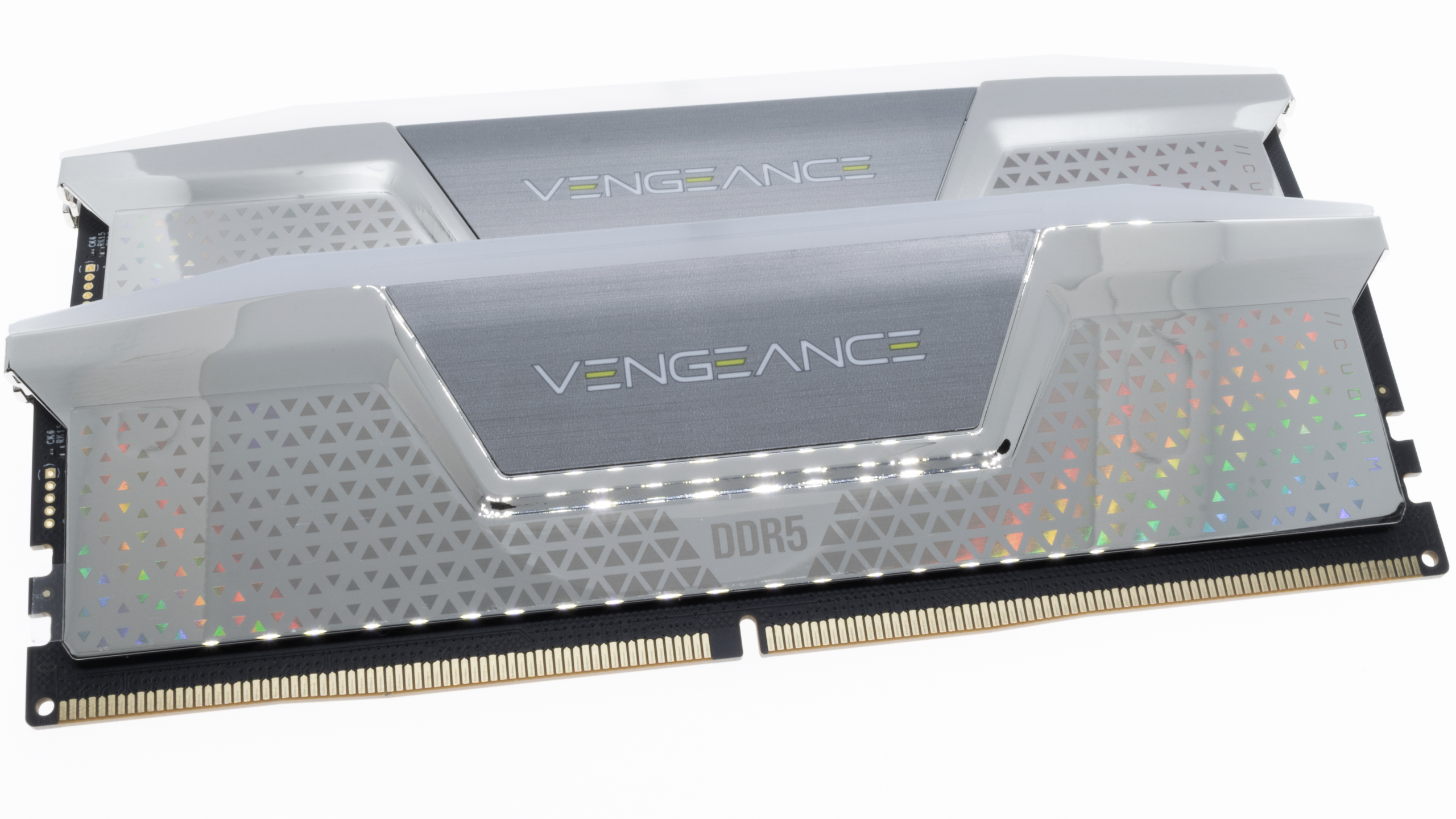
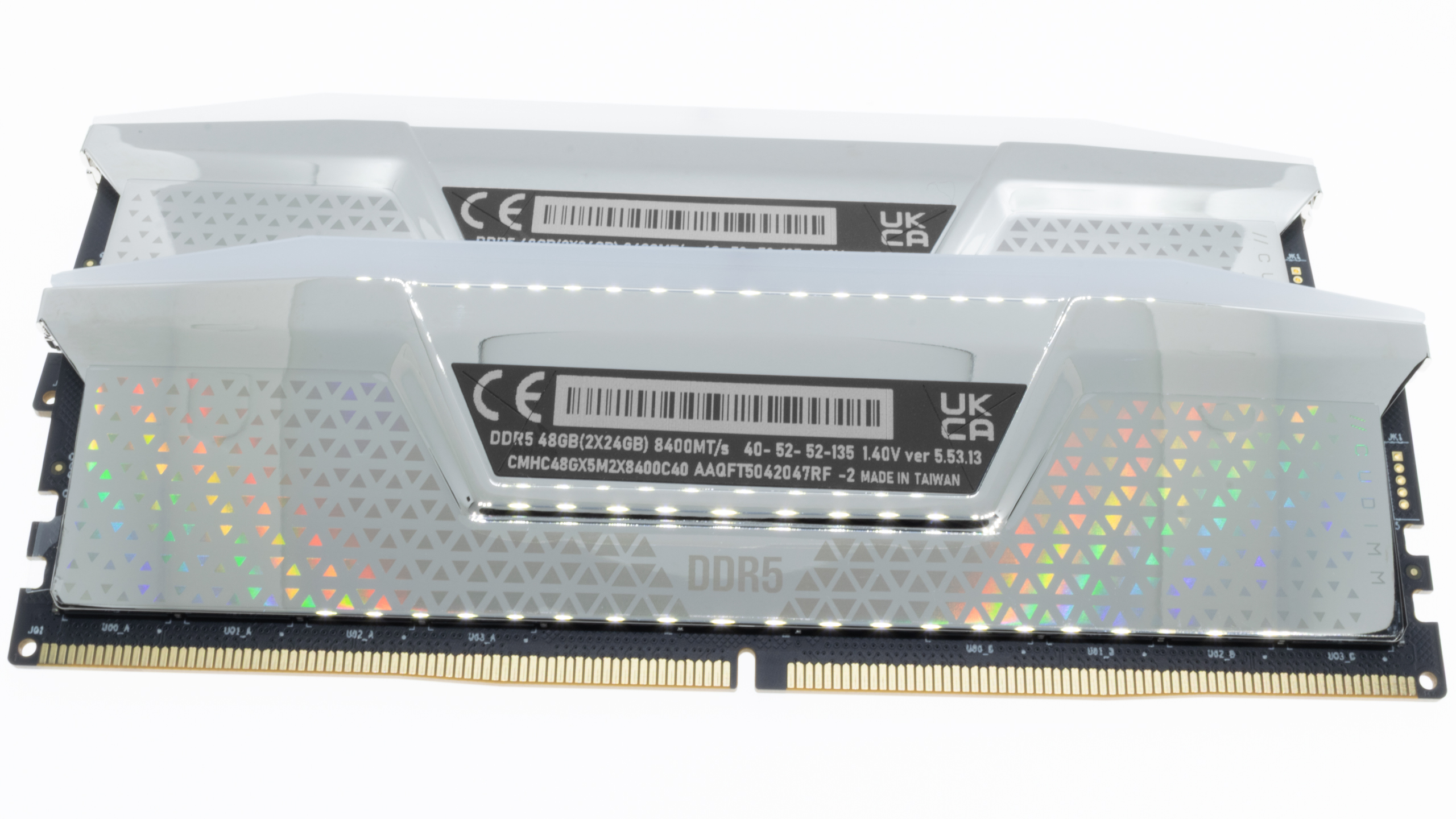
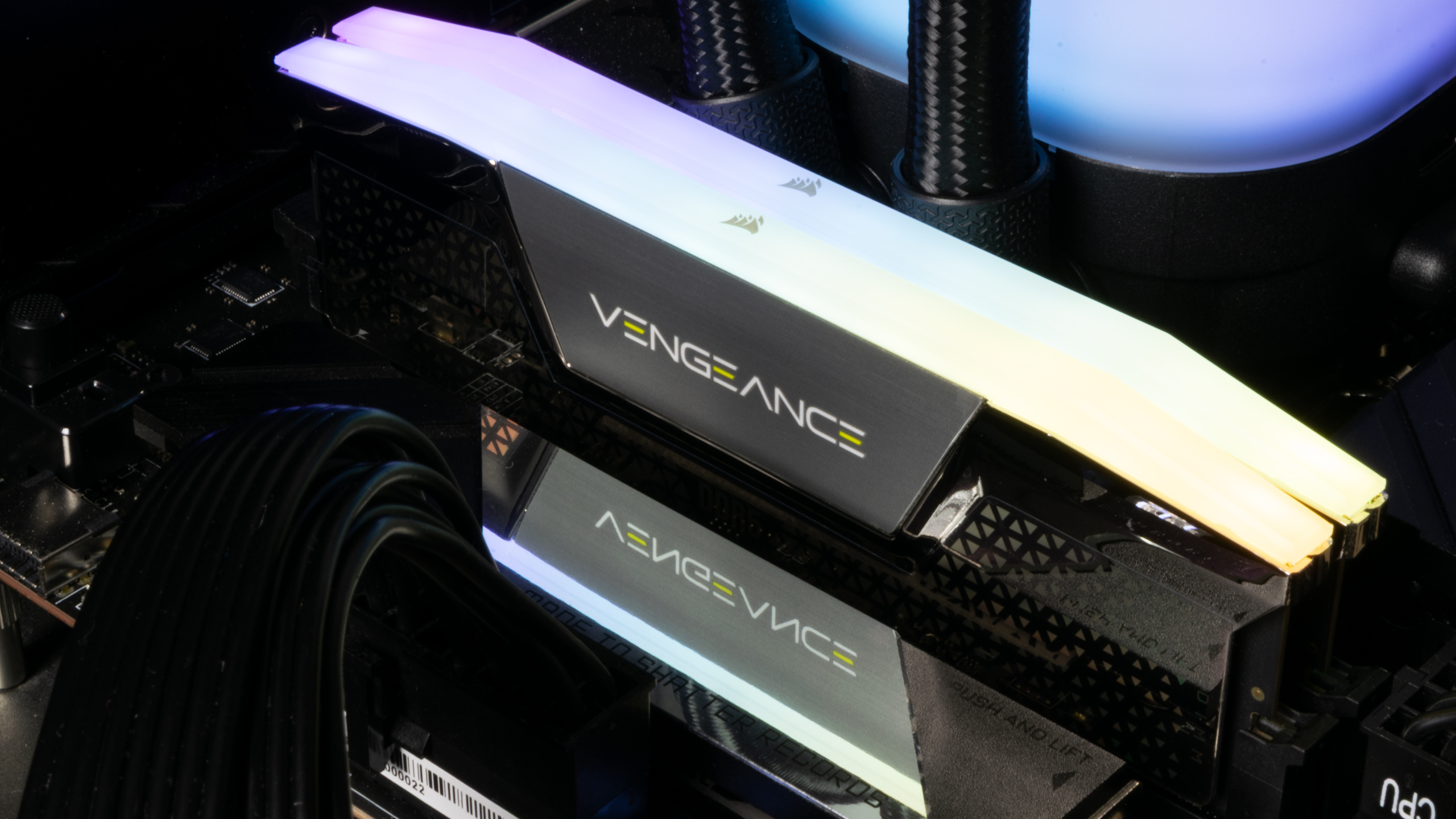
The Vengeance CUDIMMs share the same design as the standard Vengeance DDR5 memory modules, but Corsair introduced subtle adjustments to set them apart. The key distinctions in the CUDIMMs lie in the color scheme and finish. The Vengeance RGB CUDIMMs feature a silver aluminum heat spreader with an attractive, glossy finish. The recurring pattern of small triangles is still present, but the mirrored surface causes the triangles to shine vividly when light strikes the heat spreader.
Corsair offers its Vengeance CUDIMMs in both standard and RGB versions. The standard version stands 1.38 inches (35mm) tall, while the RGB version is taller at 1.74 inches (44mm). The RGB CUDIMMs feature a light bar with ten-zone dynamic lighting. Although Corsair's RGB lighting is compatible with most motherboard systems, you're still stuck with the brand's iCUE software if you want complete control over the illumination and effects.

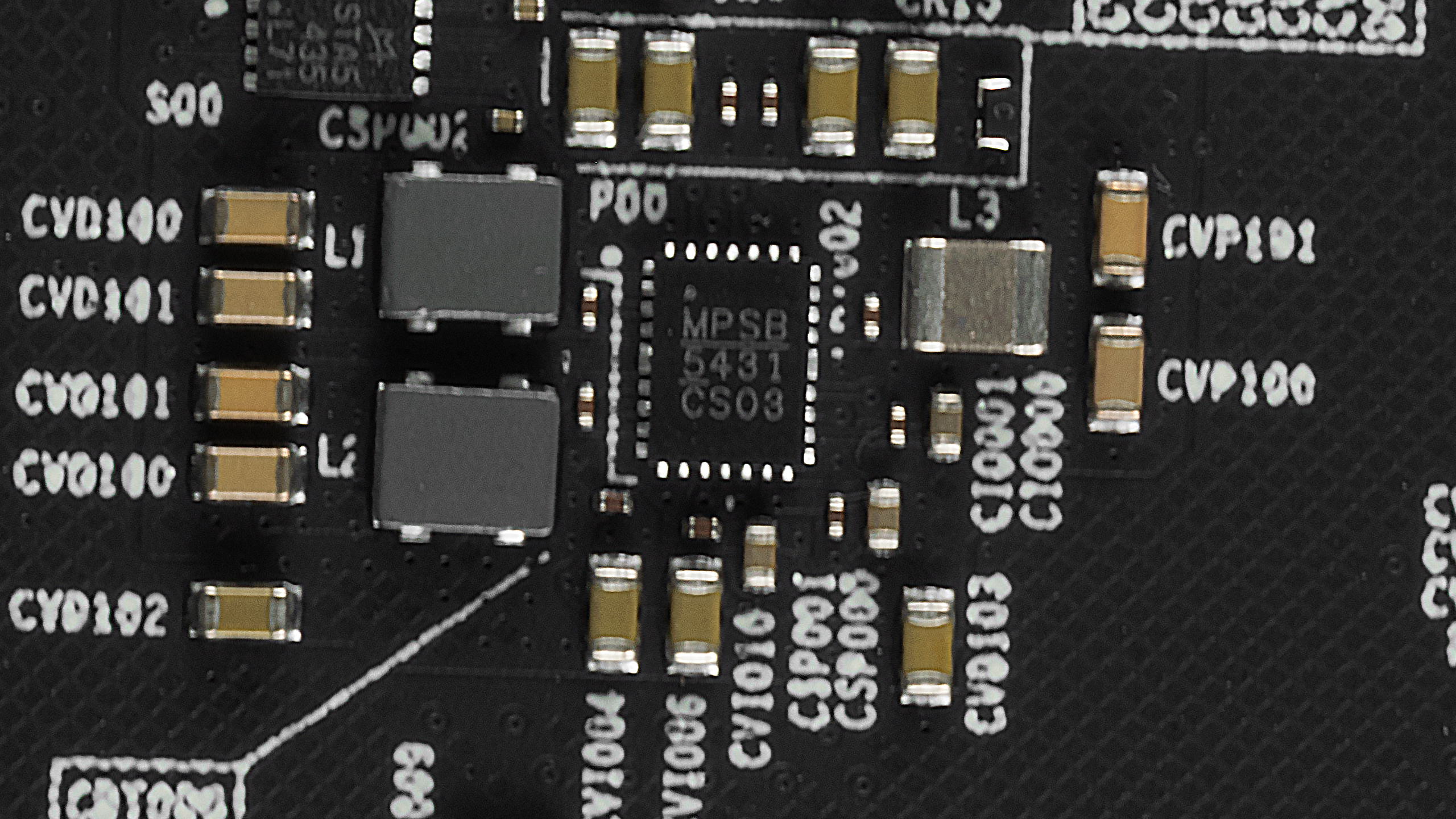
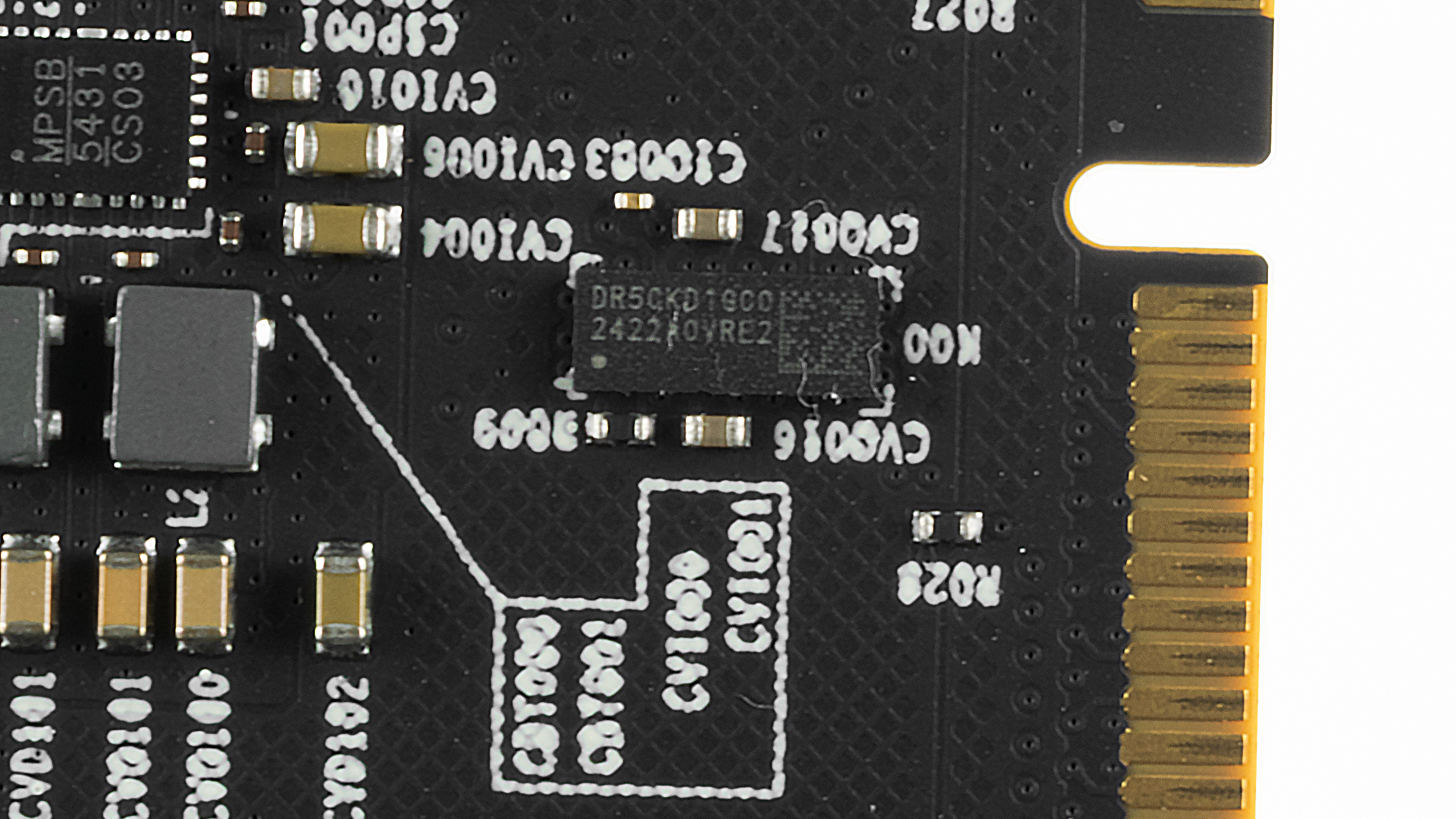
This 48GB memory kit includes two 24GB DDR5 modules featuring a single-rank design. The custom black PCB accommodates eight SK hynix H5CGD8MGBDX021 (M-die) integrated circuits (ICs) arranged on one side. Each 24GB module contains M-die ICs with a capacity of 3GB each. The power management IC (PMIC), MPSB5431CS03, is provided by Monolithic Power Systems (MPS), while the client clock driver (CKD) is the DR5CKD1GC0 from Rambus, integrated into these Vengeance CUDIMMs.
It is important to note that AMD's current 800-series platform does not fully support CUDIMMs. They will operate, albeit in bypass mode, which results in the loss of the CKD functionality.
The default settings for the Vengeance CUDIMMs are DDR5-5600 with 48-48-48-90 timings. These memory modules are intended for Intel platforms, which means they only support XMP 3.0. The DDR5-8400 profile will adjust the CUDIMMs to operate at 40-52-52-135 with a DRAM voltage of 1.4V. Interestingly, Corsair has not included backup profiles, a feature typically found in its high-end memory kits. See our PC Memory 101 feature and How to Shop for RAM story for more timings and frequency considerations.
Comparison Hardware
Memory Kit | Part Number | Capacity | Data Rate | Primary Timings | Voltage | Warranty |
|---|---|---|---|---|---|---|
G.Skill Trident Z5 CK | F5-8800C4255H24GX2-TZ5CK | 2 x 24GB | DDR5-8800 (XMP) | 42-55-55-140 (2T) | 1.45 | Lifetime |
Corsair Vengeance RGB CUDIMM | CMHC48GX5M2X8400C40 | 2 x 24GB | DDR5-8400 (XMP) | 40-52-52-135 (2T) | 1.40 | Lifetime |
TeamGroup T-Force Xtreem | FFPD548G7200HC34ADC01 | 2 x 24GB | DDR5-7200 (XMP) | 34-42-42-84 (2T) | 1.40 | Lifetime |
G.Skill Trident Z5 RGB | F5-7200J3646F24GX2-TZ5RK | 2 x 24GB | DDR5-7200 (XMP) | 36-46-46-115 (2T) | 1.35 | Lifetime |
Corsair Dominator Titanium First Edition | CMP48GX5M2X7200C36FEW | 2 x 24GB | DDR5-7200 (XMP) | 36-46-46-116 (2T) | 1.40 | Lifetime |
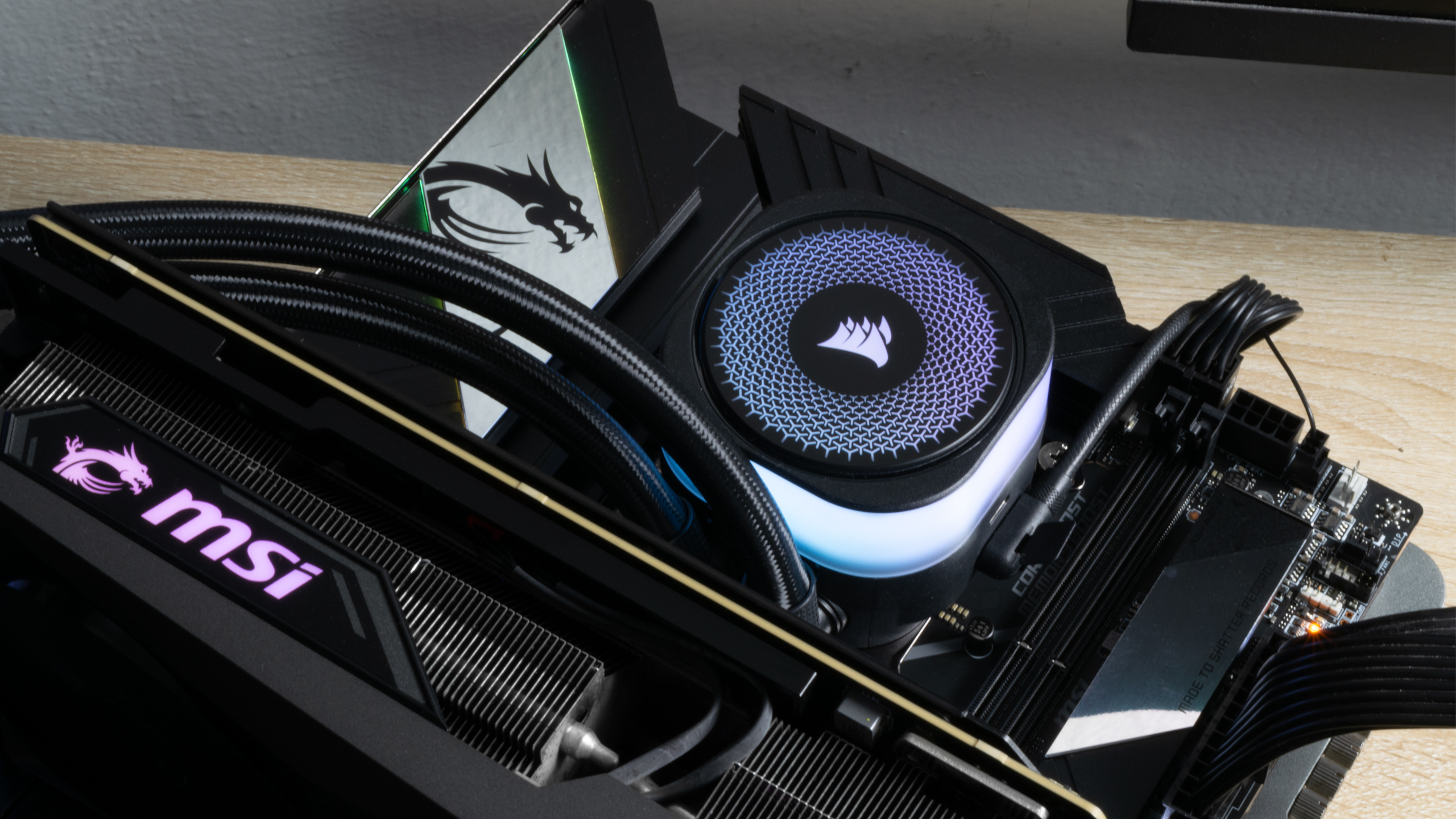
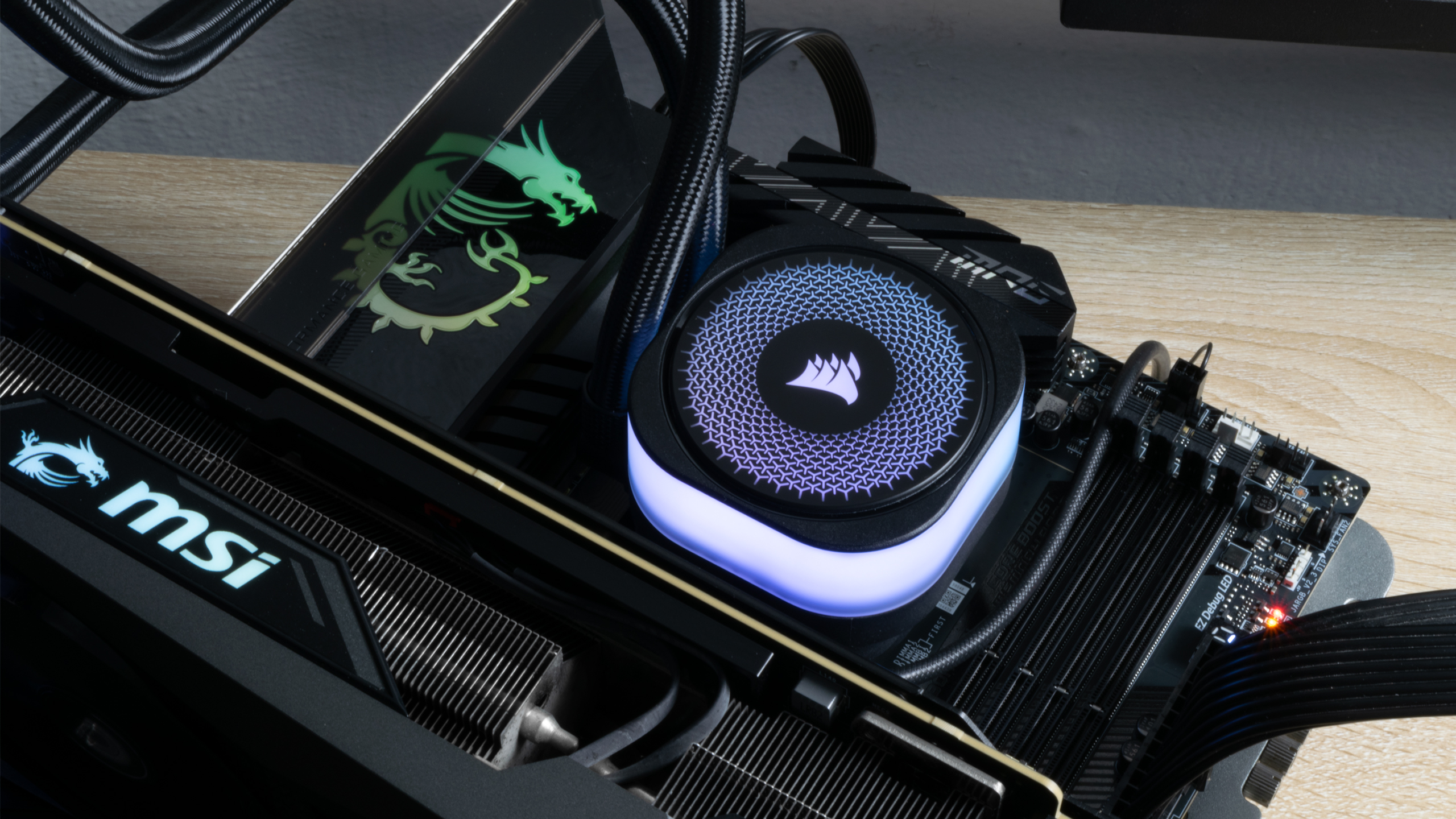
The Intel system comprises the Core Ultra 9 285K and the MSI MEG Z890 Unify-X (7E20v1A41 firmware). In contrast, the AMD system employs the Ryzen 9 9900X and MSI MPG X870E Carbon WiFi (7E49v1A23 firmware). The Corsair iCUE Link Titan 360 RX LCD CPU liquid cooler effectively maintains the operating temperatures of both the Arrow Lake and Zen 5 processors under optimal conditions.
Get Tom's Hardware's best news and in-depth reviews, straight to your inbox.
The MSI GeForce RTX 4080 16GB Gaming X Trio addresses the more graphics-intensive workloads, ensuring that our gaming RAM benchmarks do not have a graphics bottleneck. TeamGroup's A440 Lite PCIe 4.0 SSD balances performance and storage capacity, with 2TB of high-speed storage up to 7,400 MB/s for our Windows 11 24H2 installation, benchmarking software, and games.
Meanwhile, the Corsair RM1000x Shift ATX 3.0 power supply delivers a reliable and ample power source to our test systems, directly feeding the GeForce RTX 4080 with a native 16-pin (12VHPWR) power cable. Finally, the Streacom BC1 open-air test bench accommodates all of our hardware.
Component | Intel System | AMD System |
|---|---|---|
Processor | Intel Core Ultra 9 285K | AMD Ryzen 9 9900X |
Motherboard | MSI MEG Z890 Unify-X | MSI MPG X870E Carbon WiFi |
Graphics Card | MSI GeForce RTX 4080 16GB Gaming X Trio | MSI GeForce RTX 4080 16GB Gaming X Trio |
Storage | TeamGroup A440 Lite 2TB | TeamGroup A440 Lite 2TB |
Cooling | Corsair iCUE Link Titan 360 RX LCD | Corsair iCUE Link Titan 360 RX LCD |
Power Supply | Corsair RM1000x Shift | Corsair RM1000x Shift |
Case | Streacom BC1 | Streacom BC1 |
Intel Performance
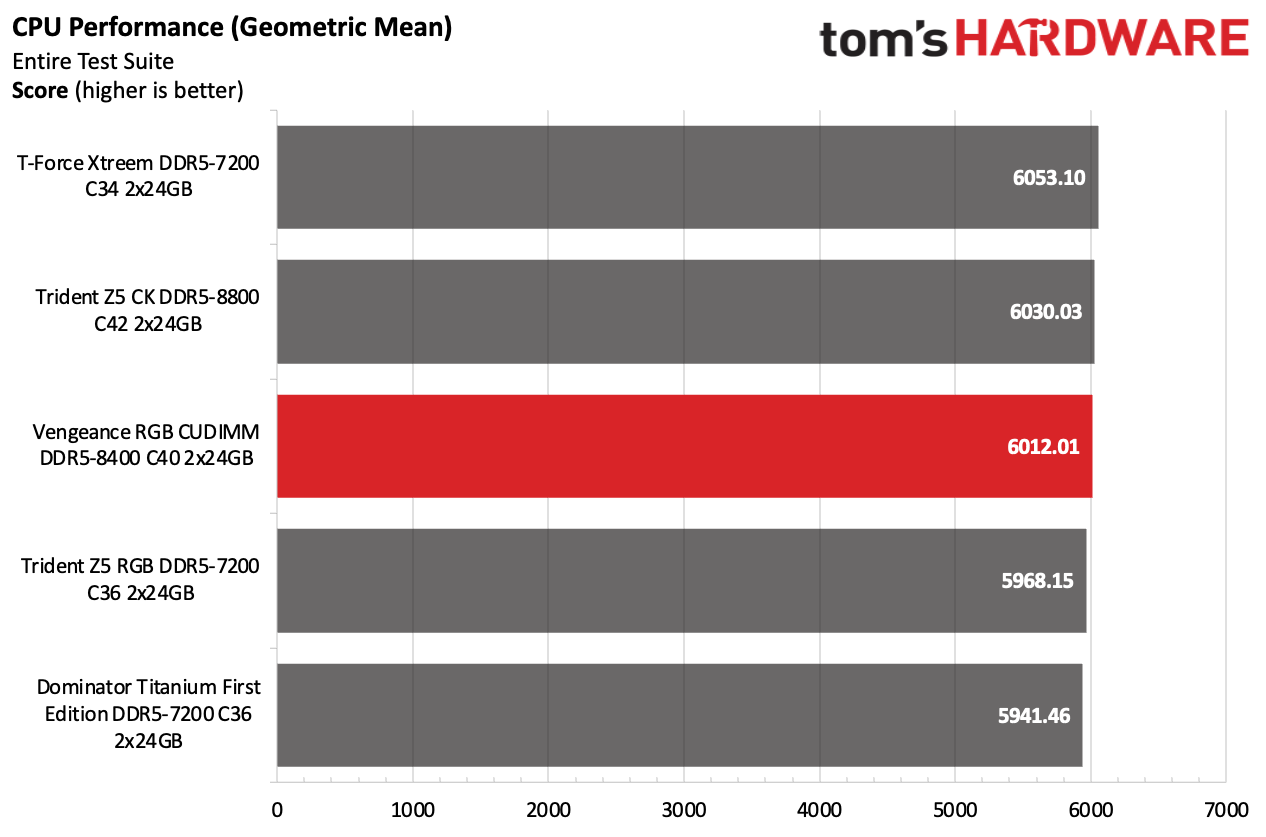
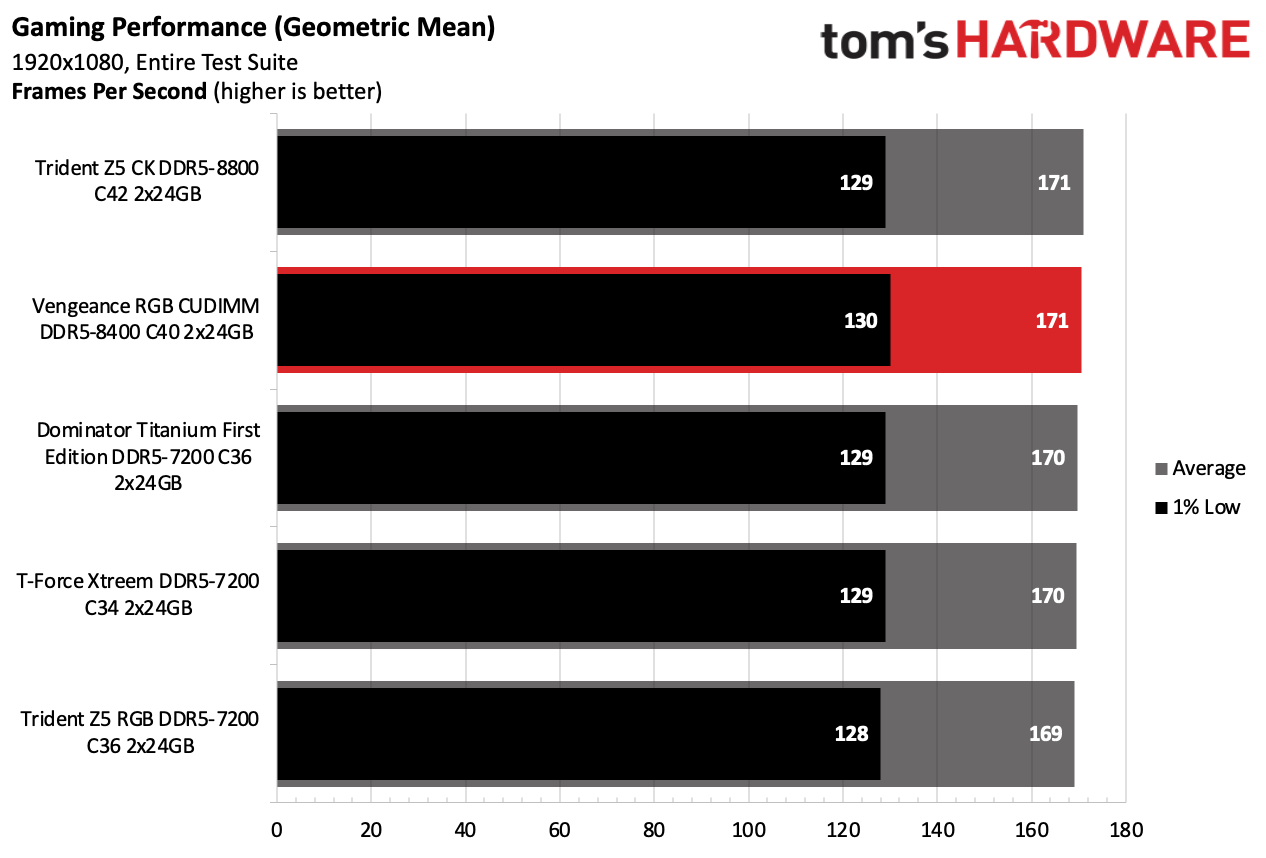
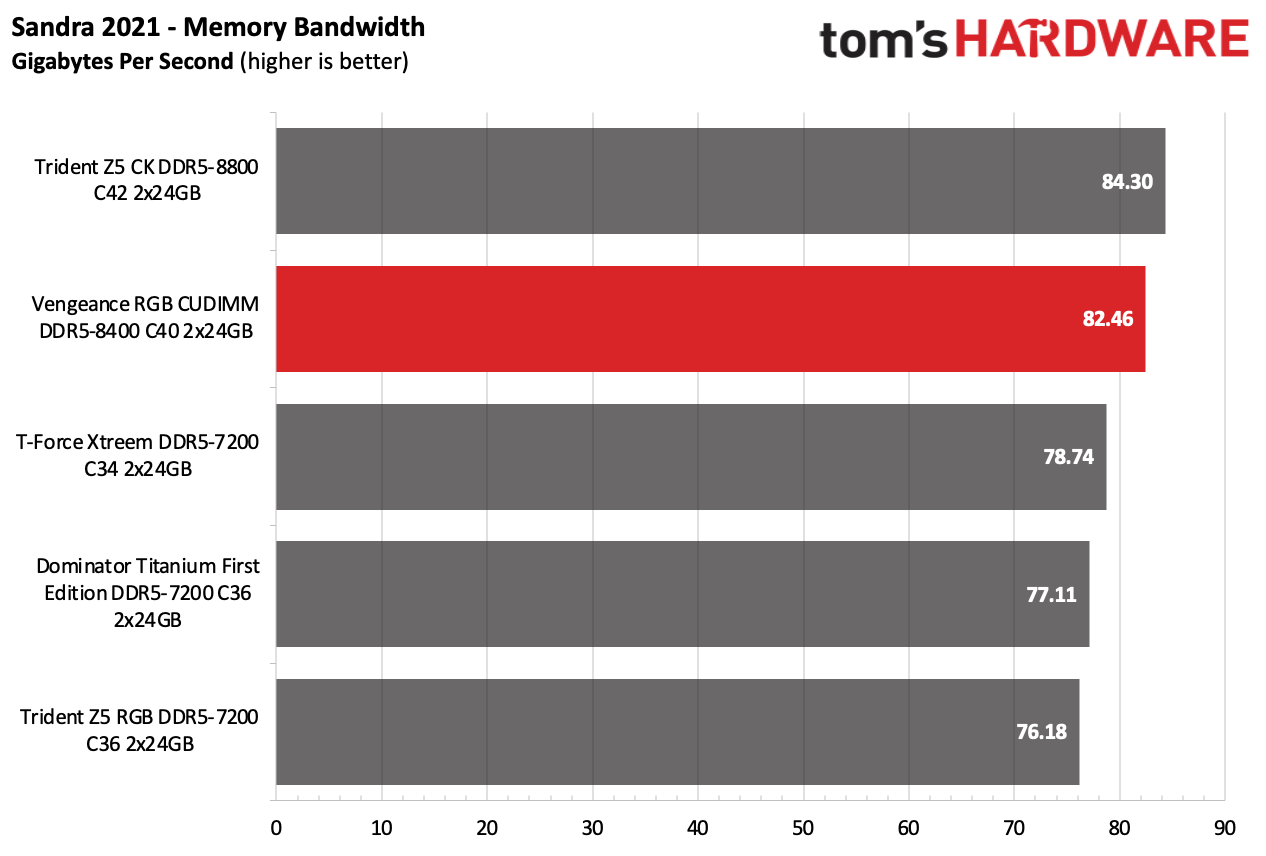
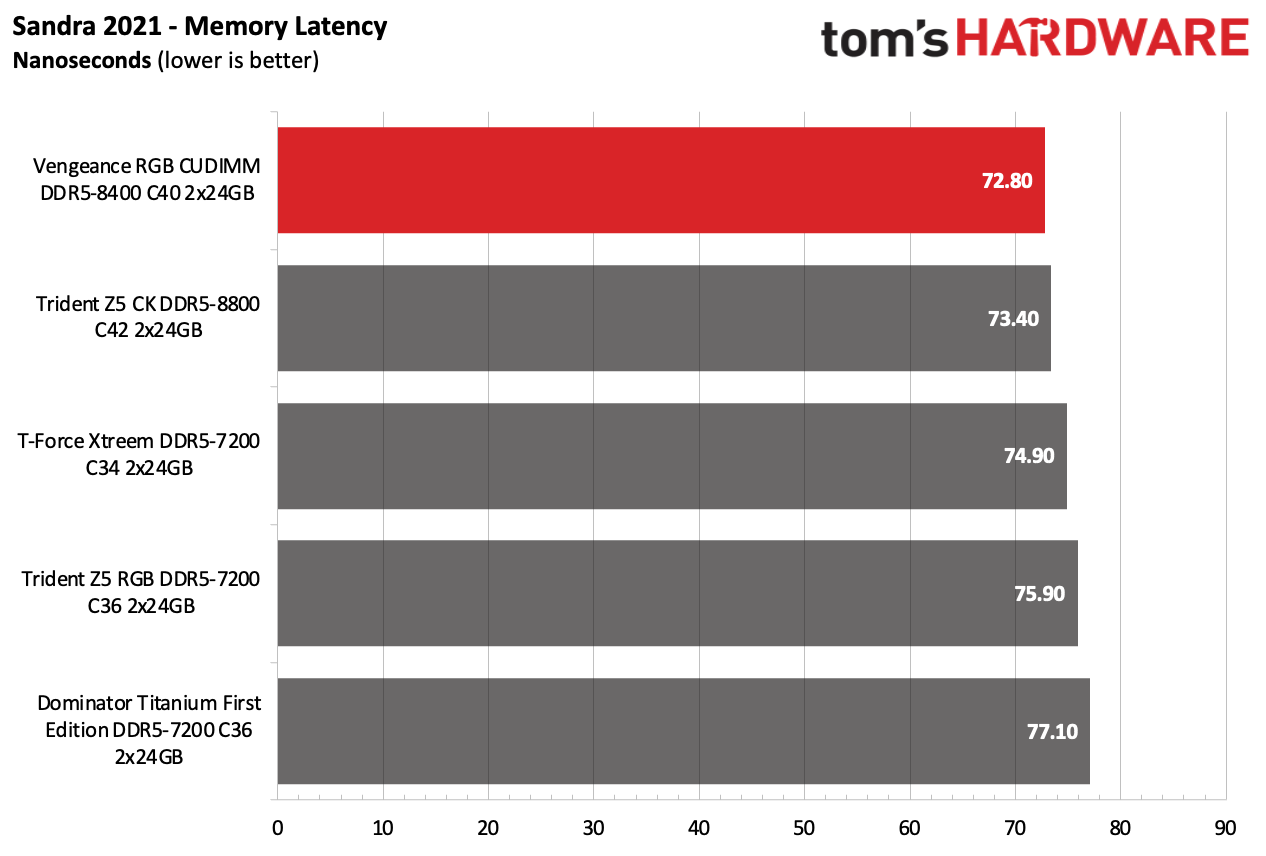
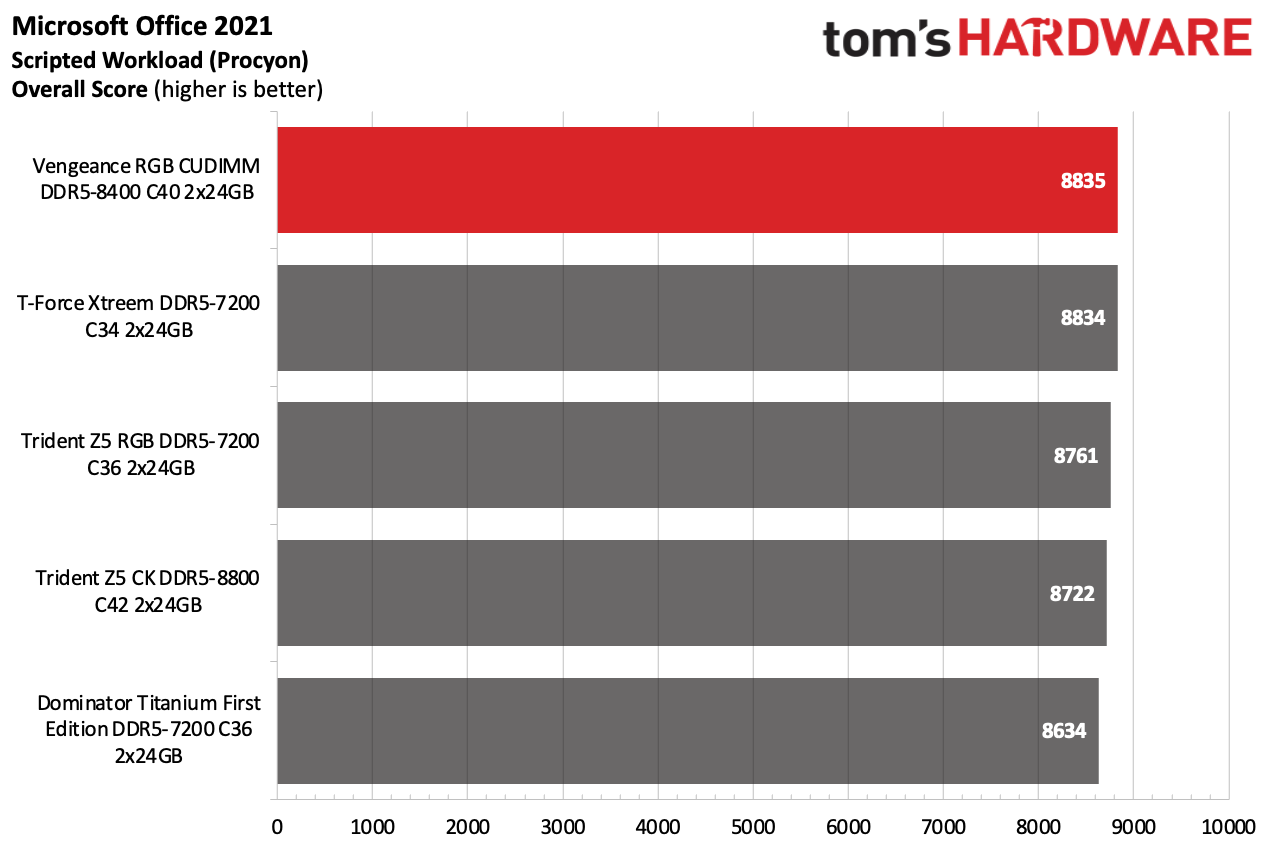
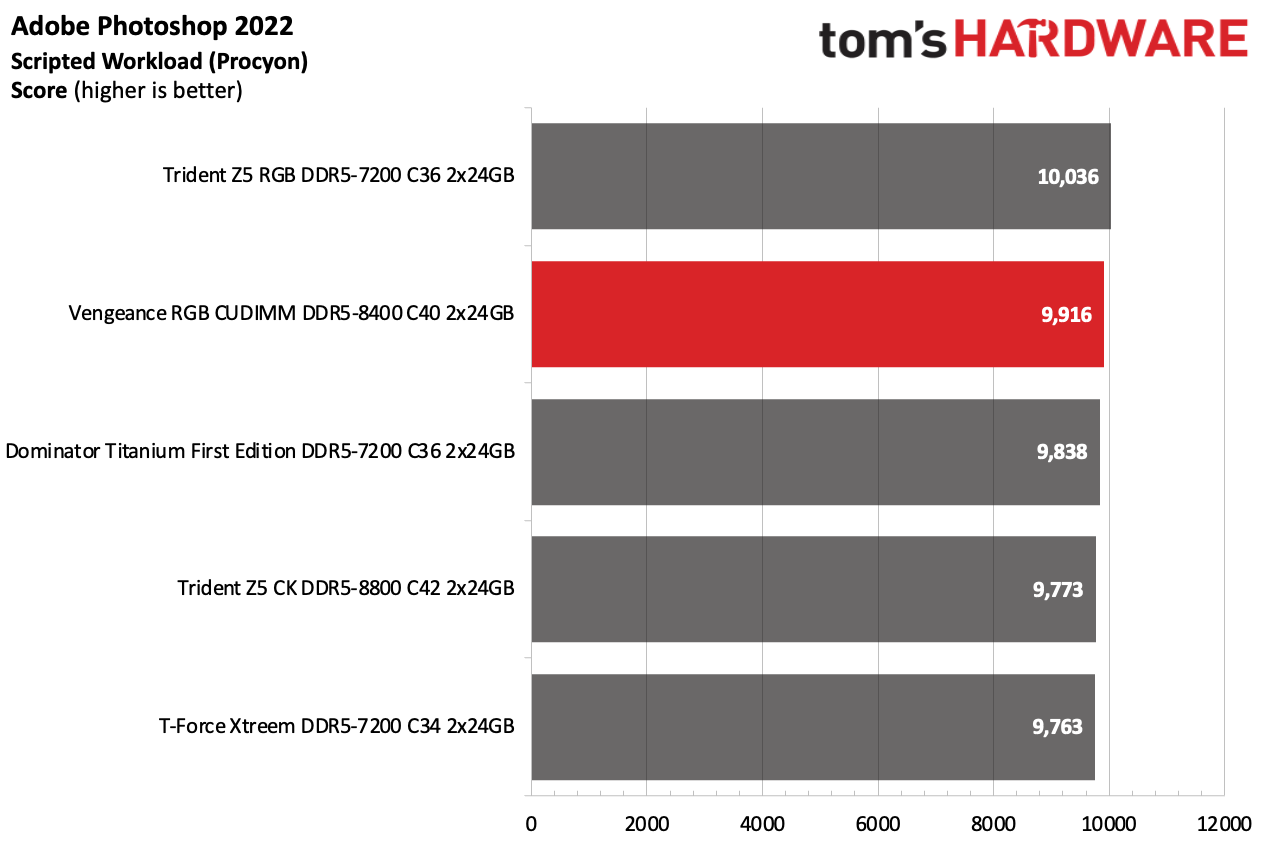
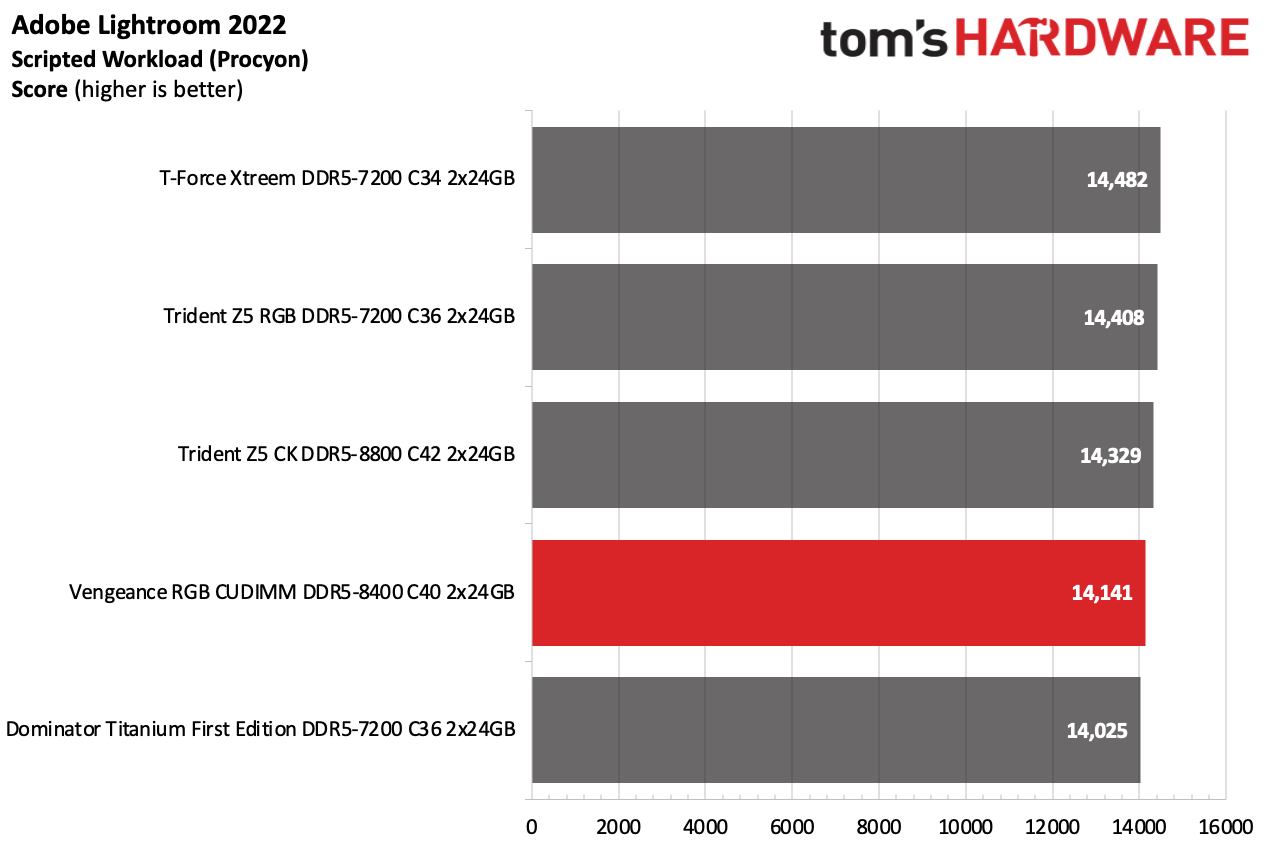
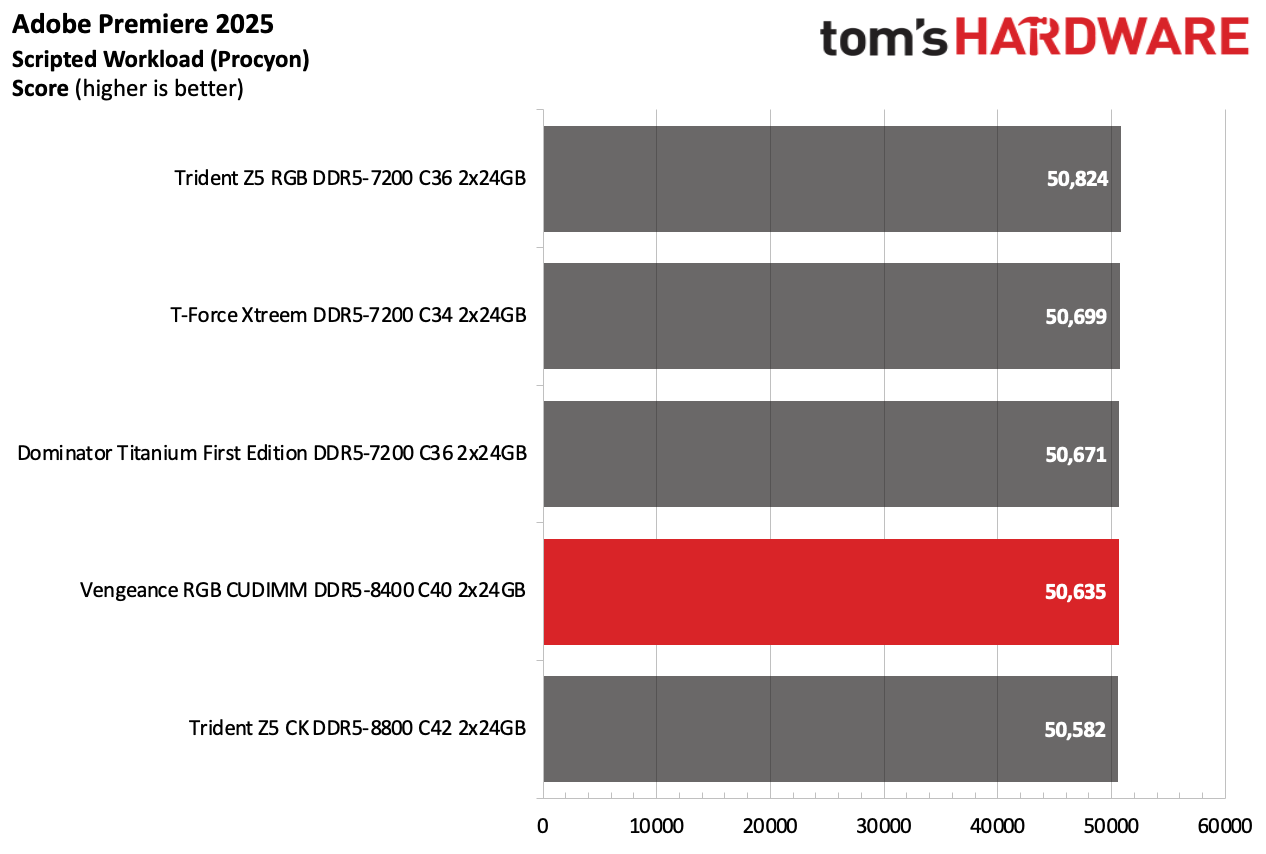
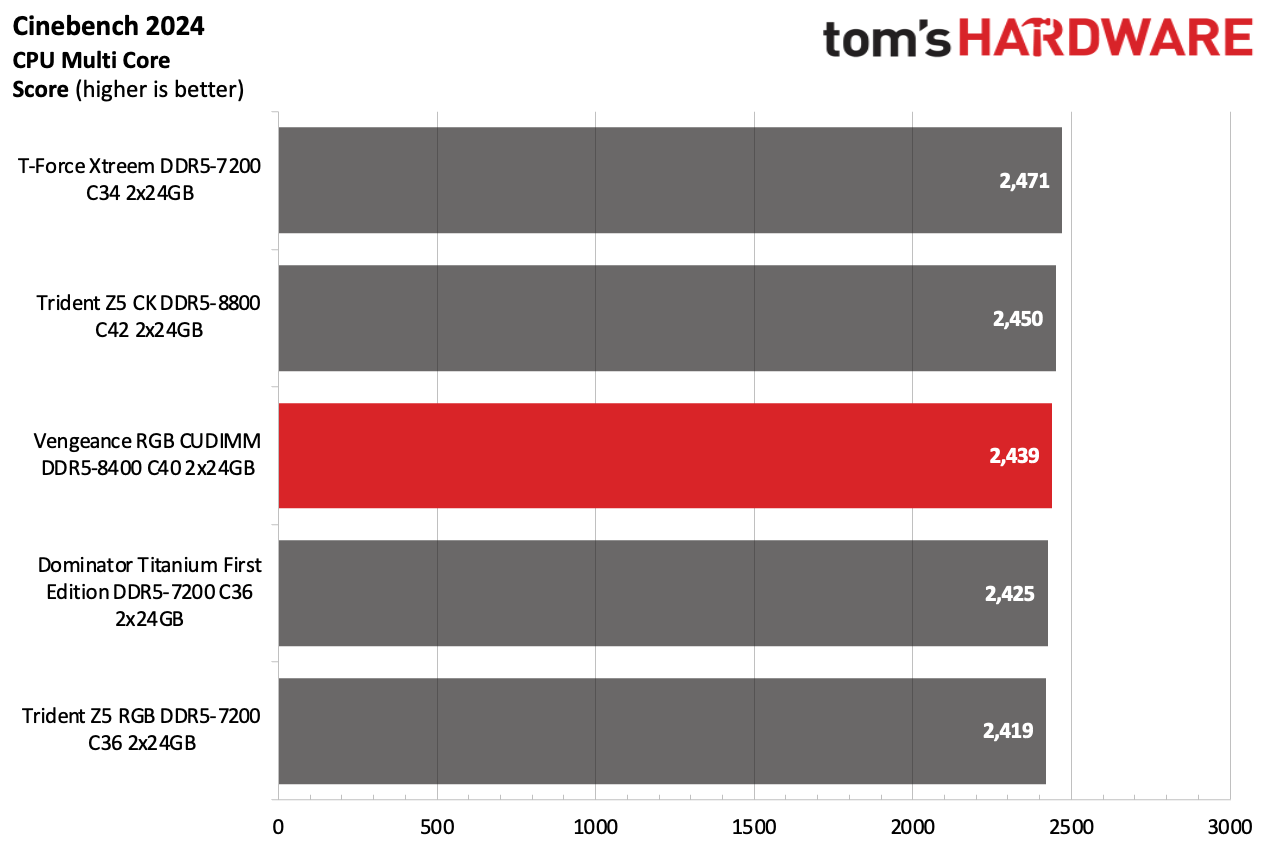
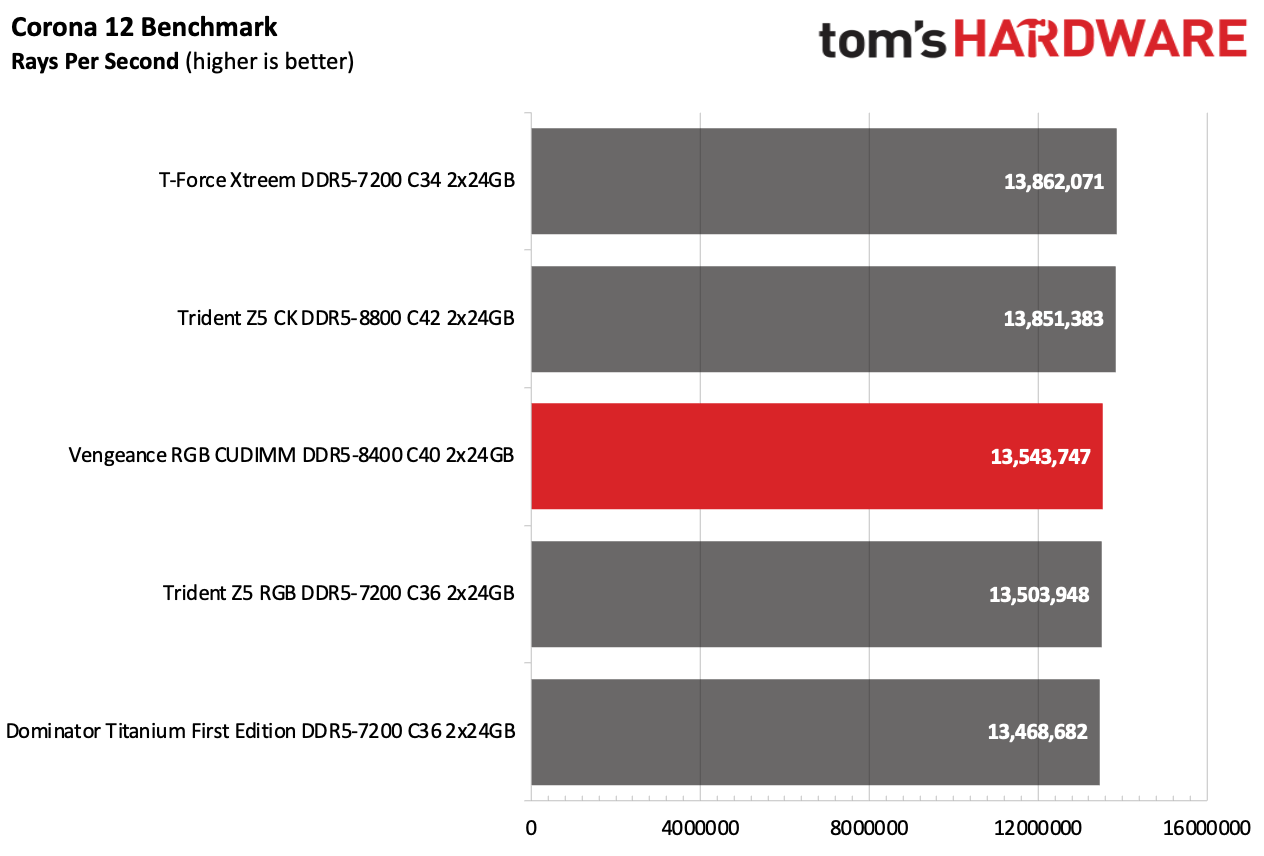
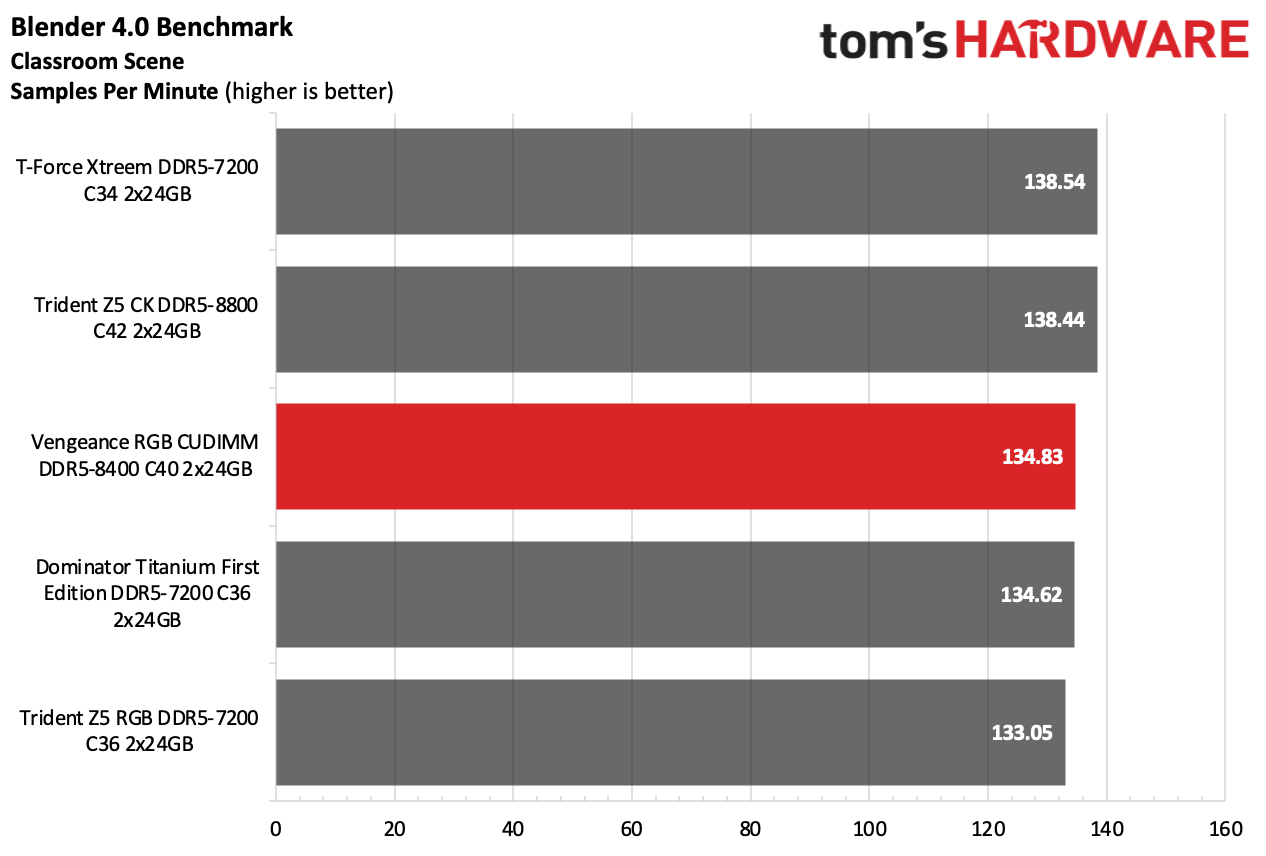
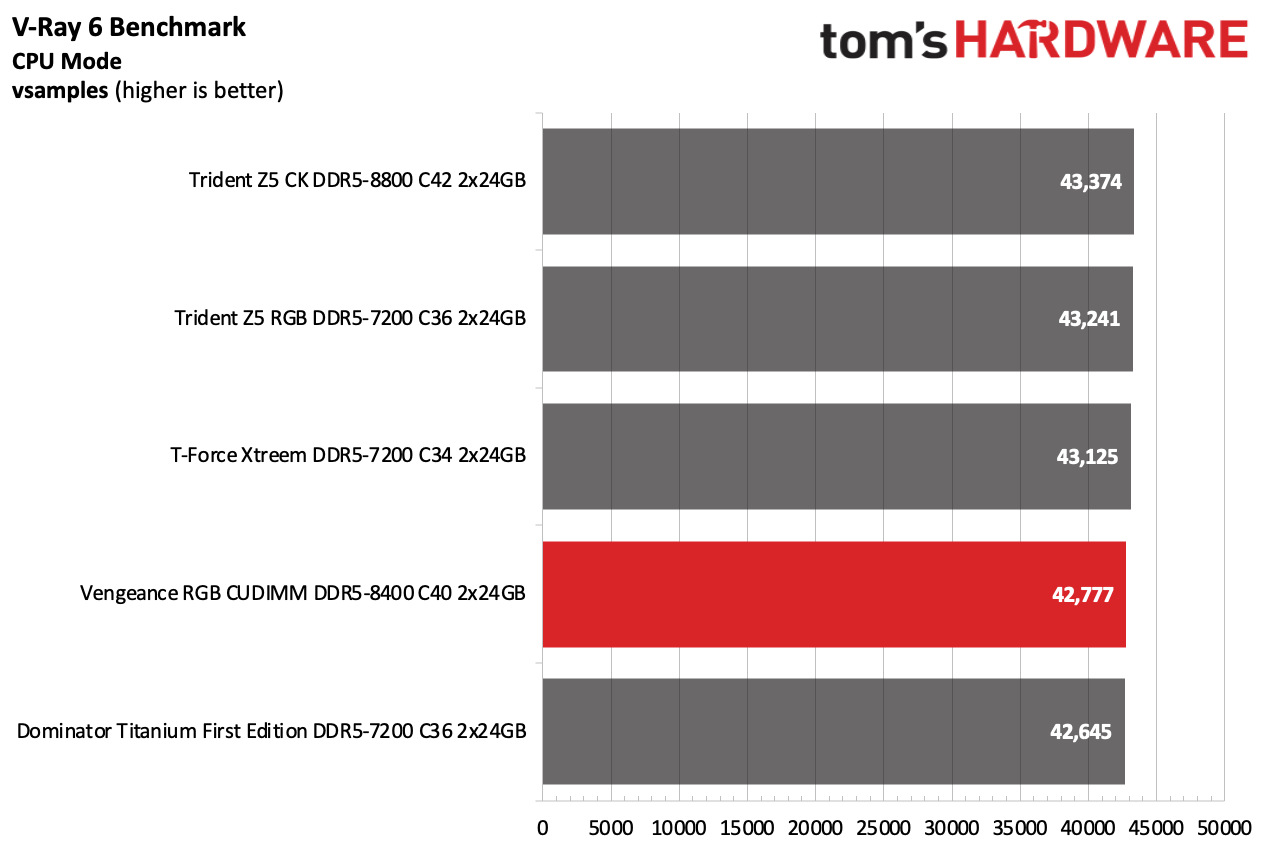
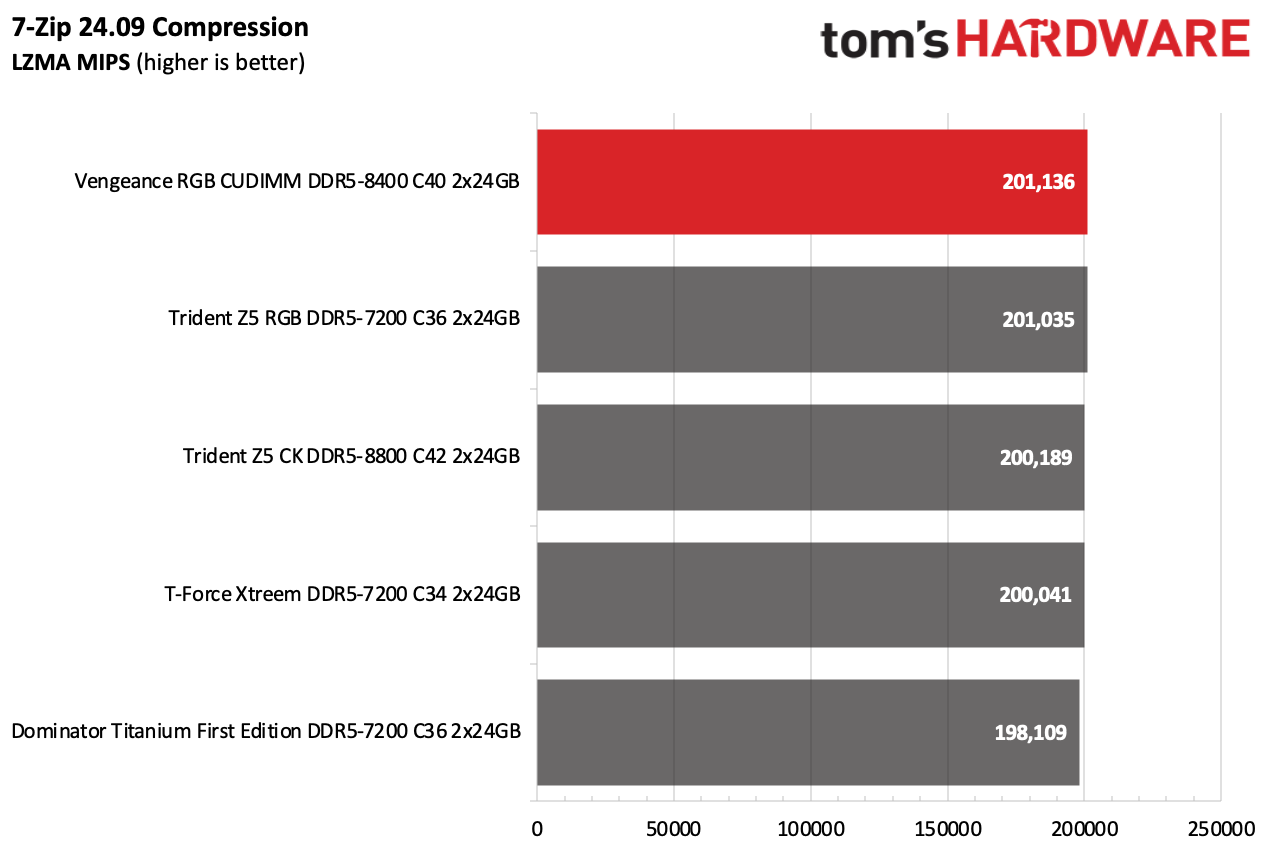
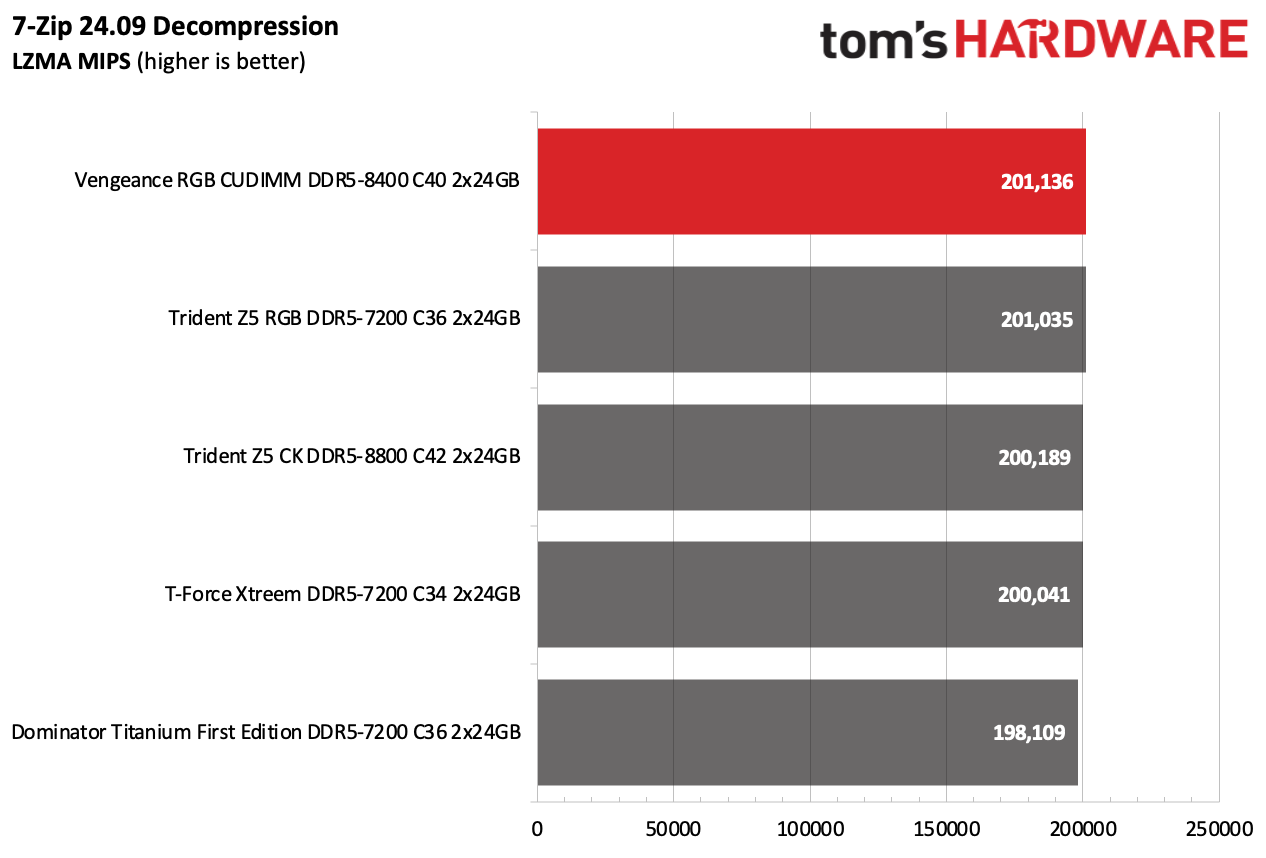
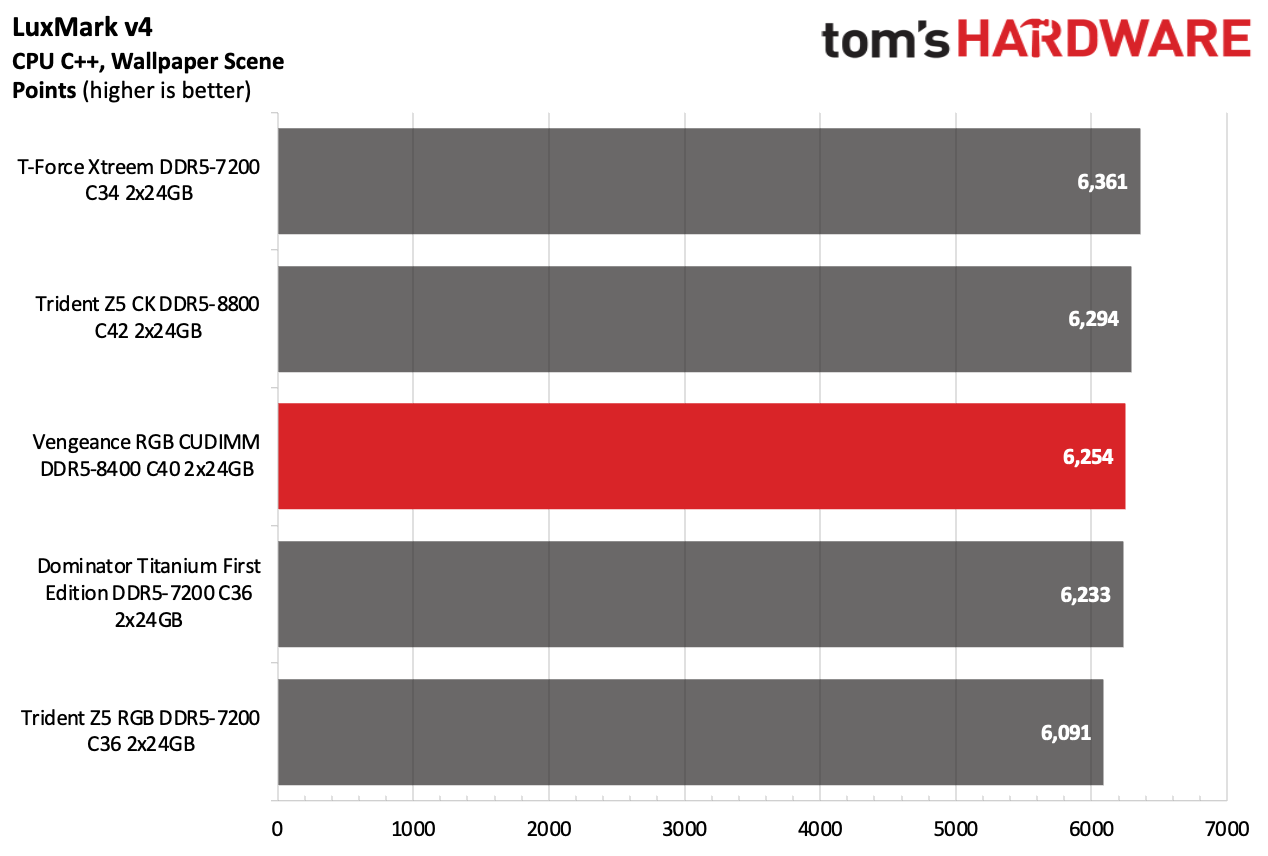
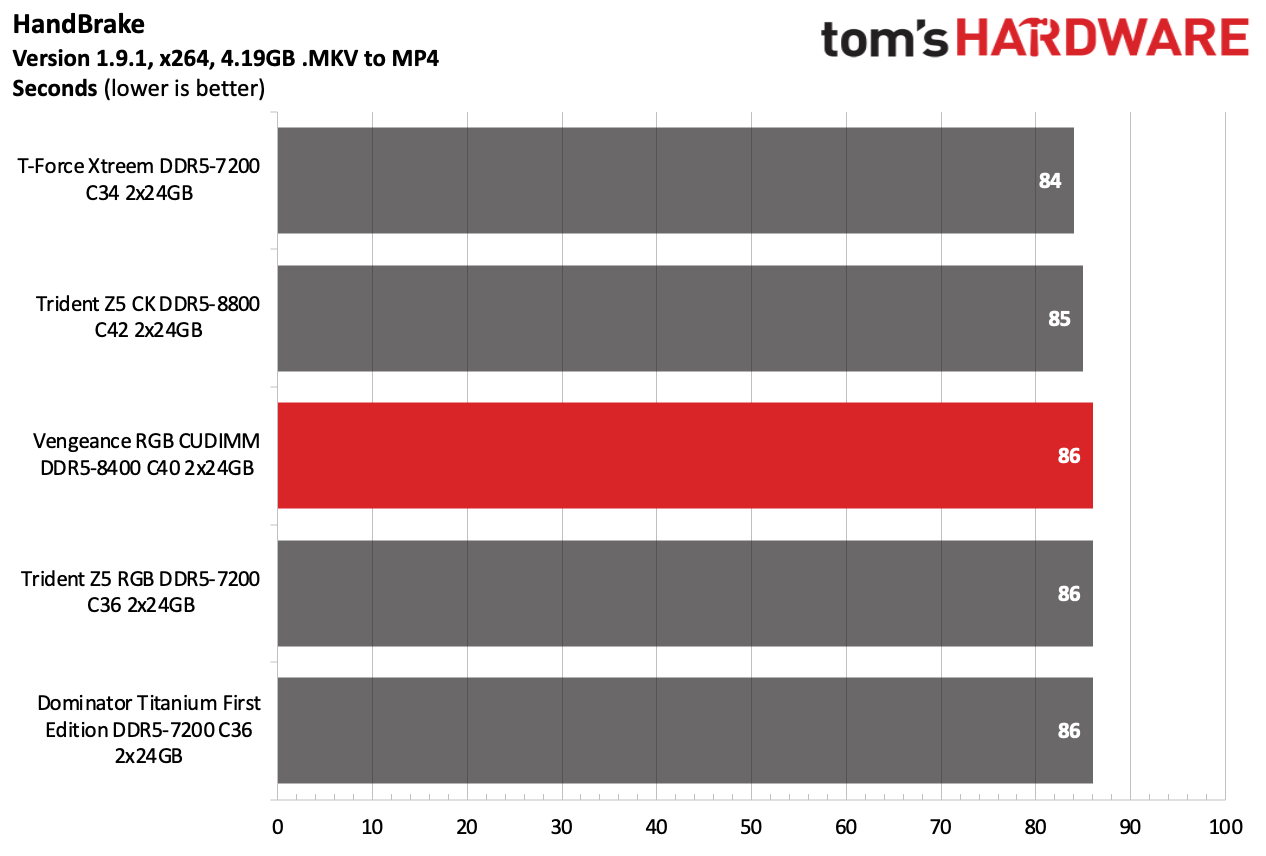
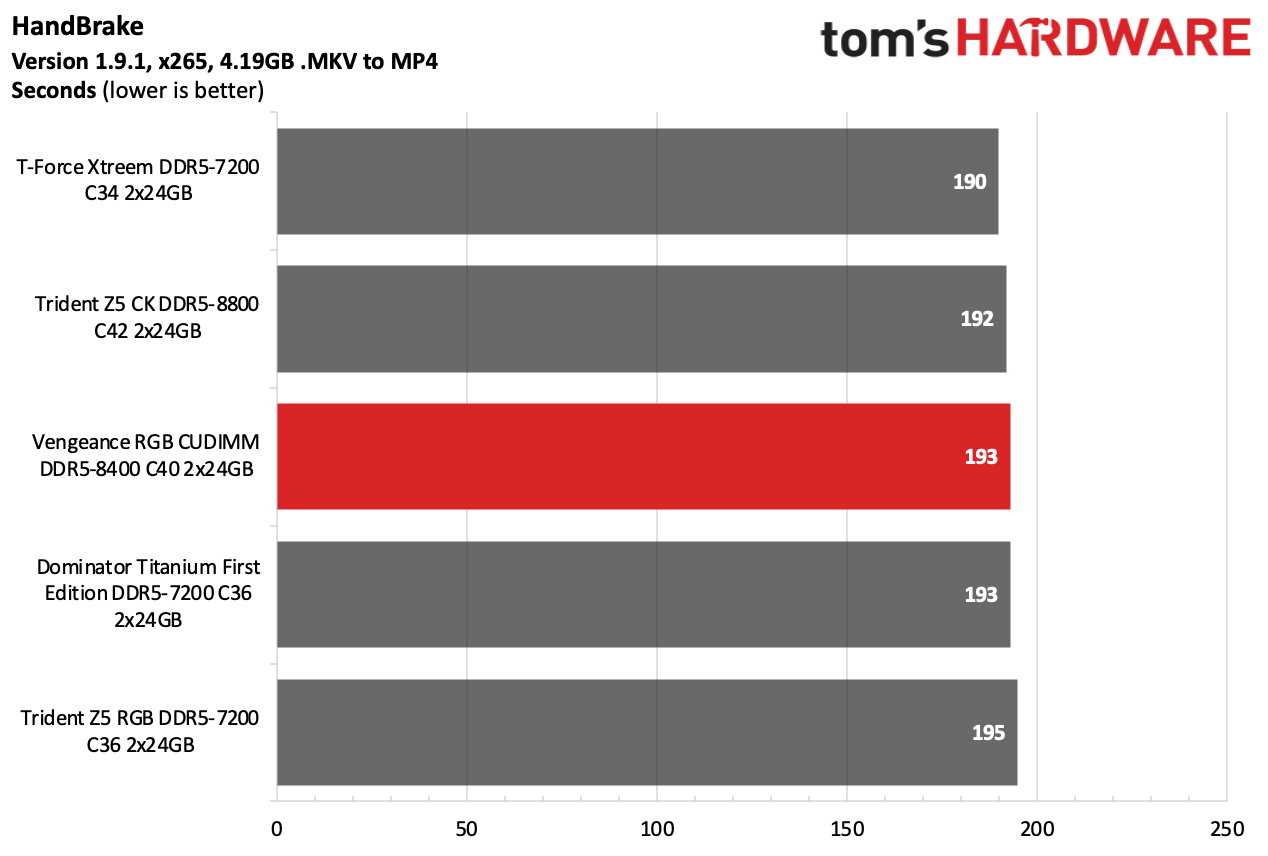
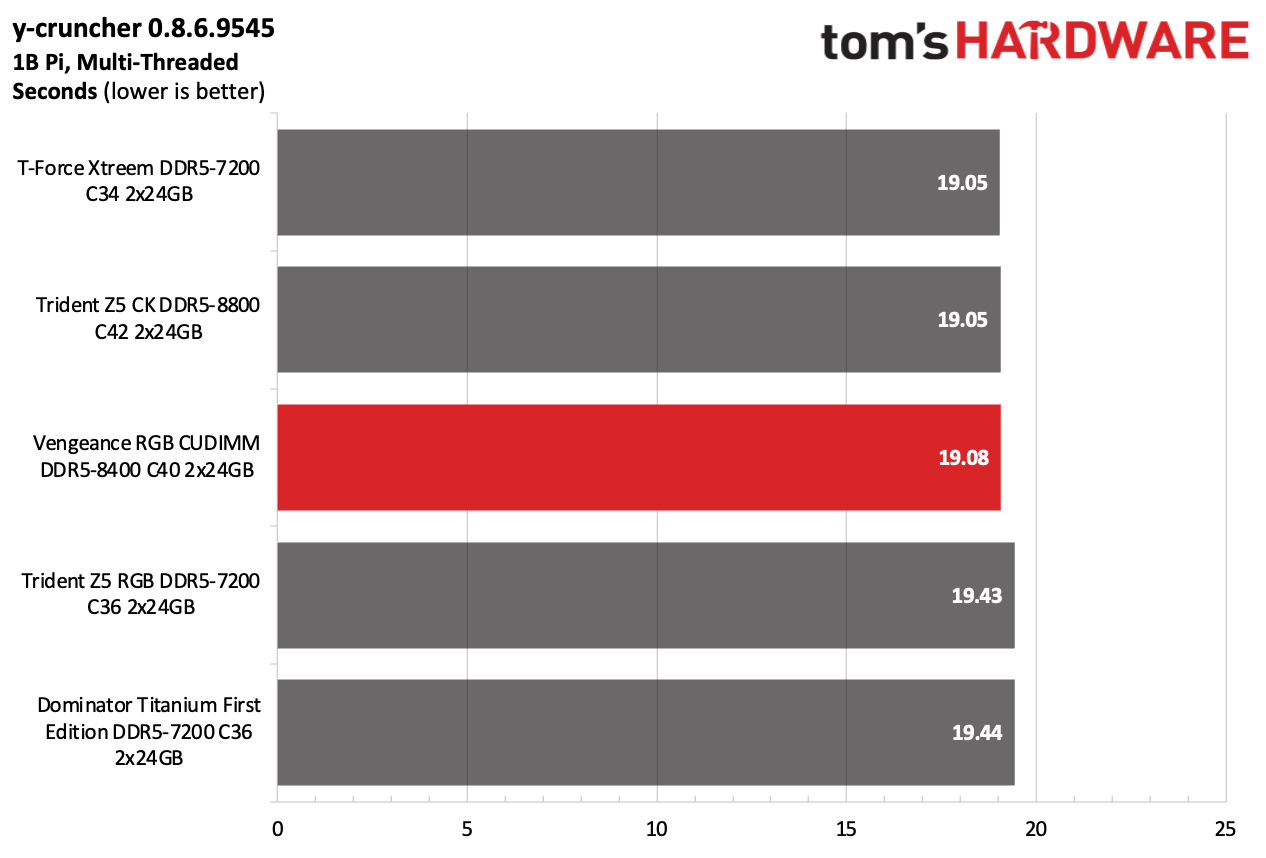
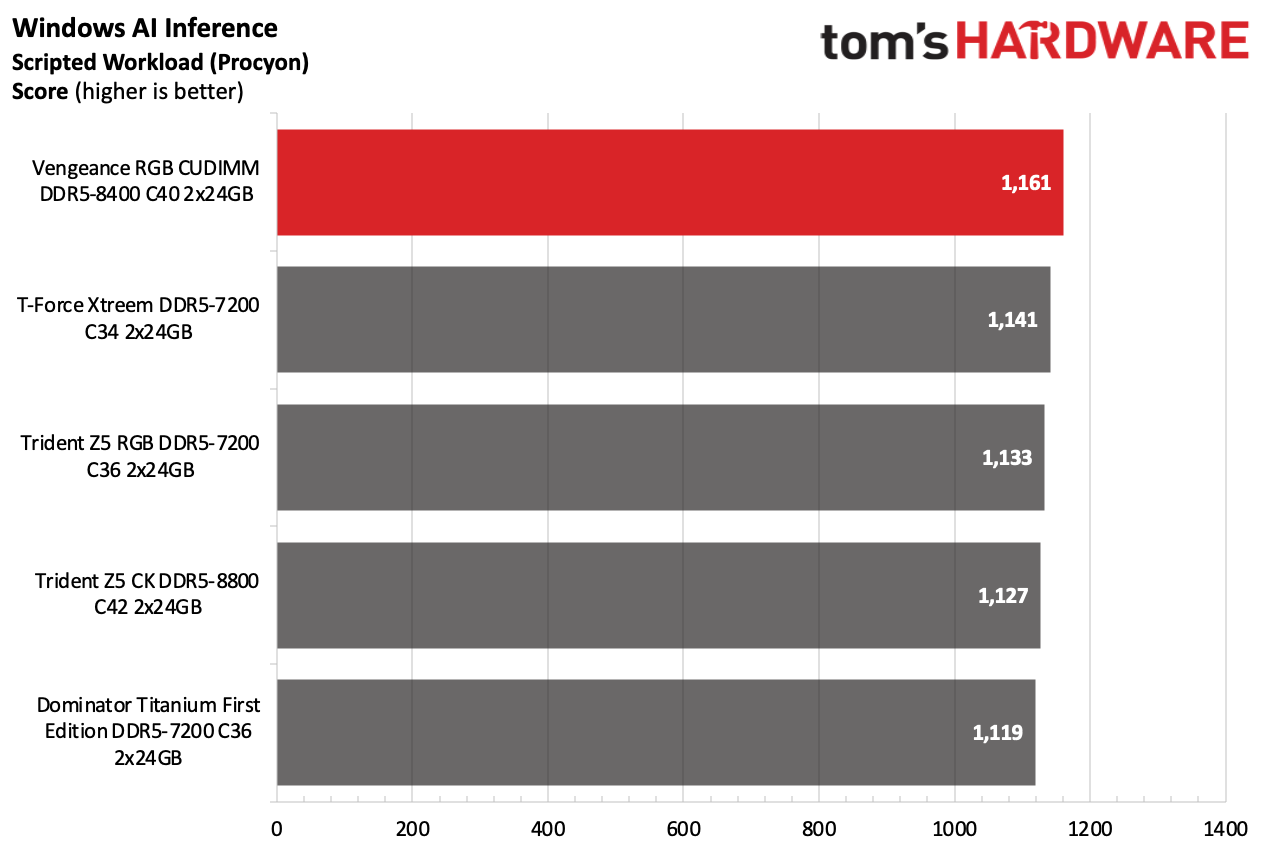
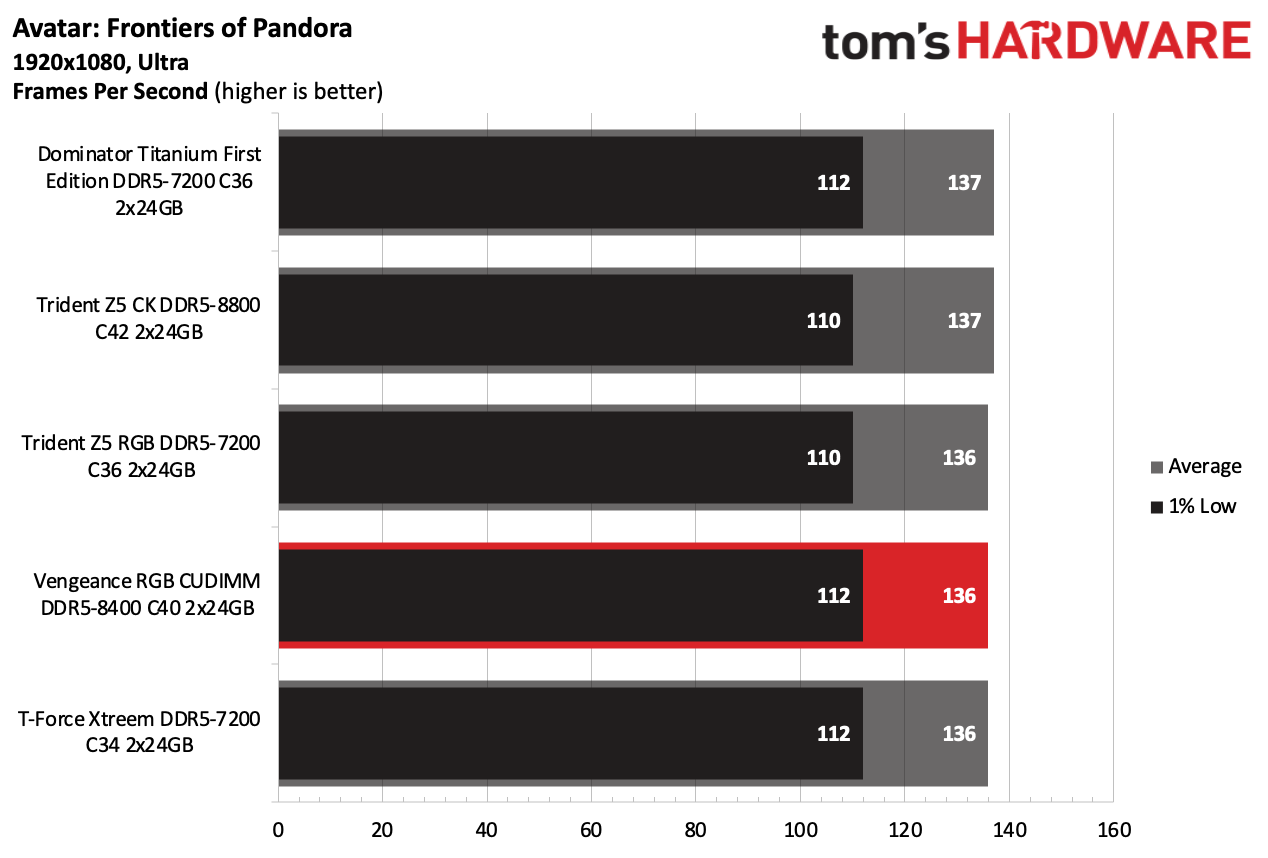
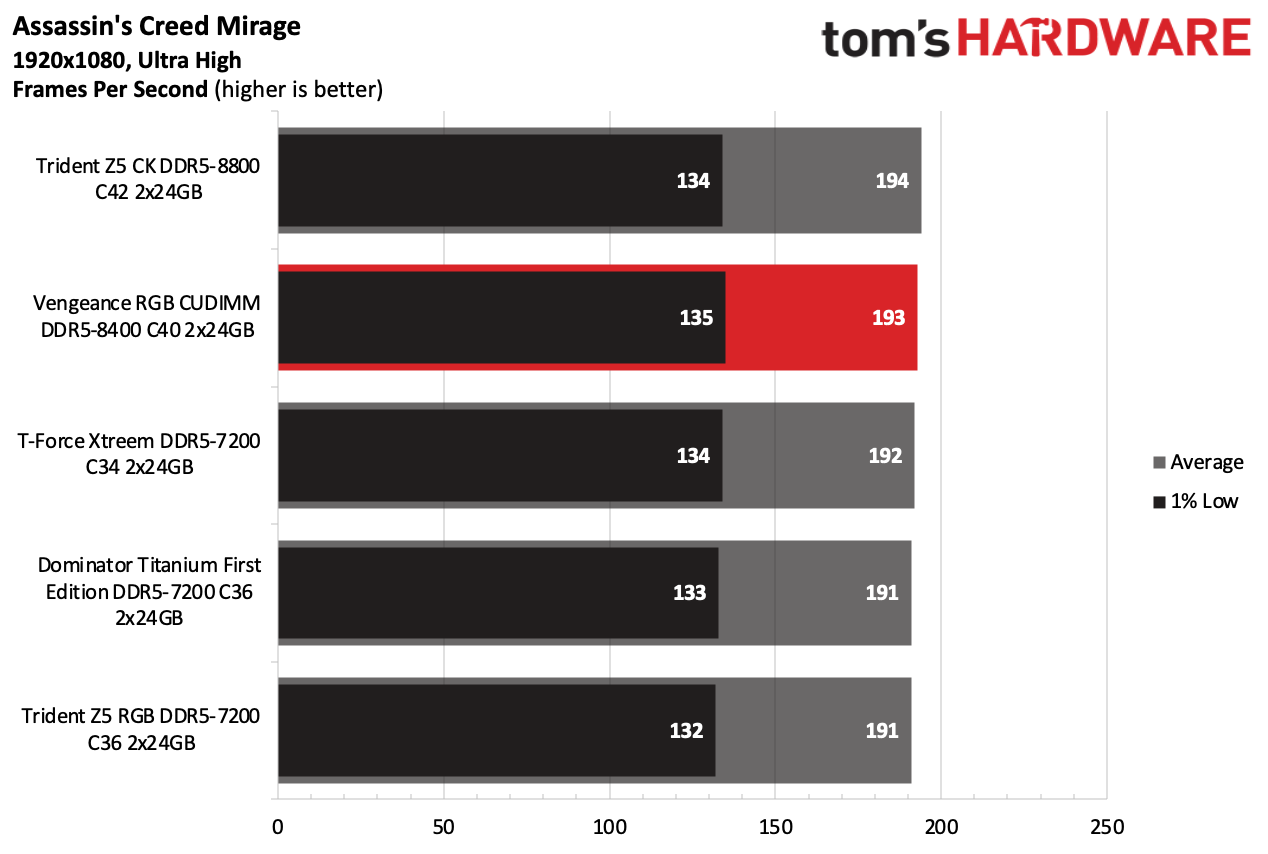
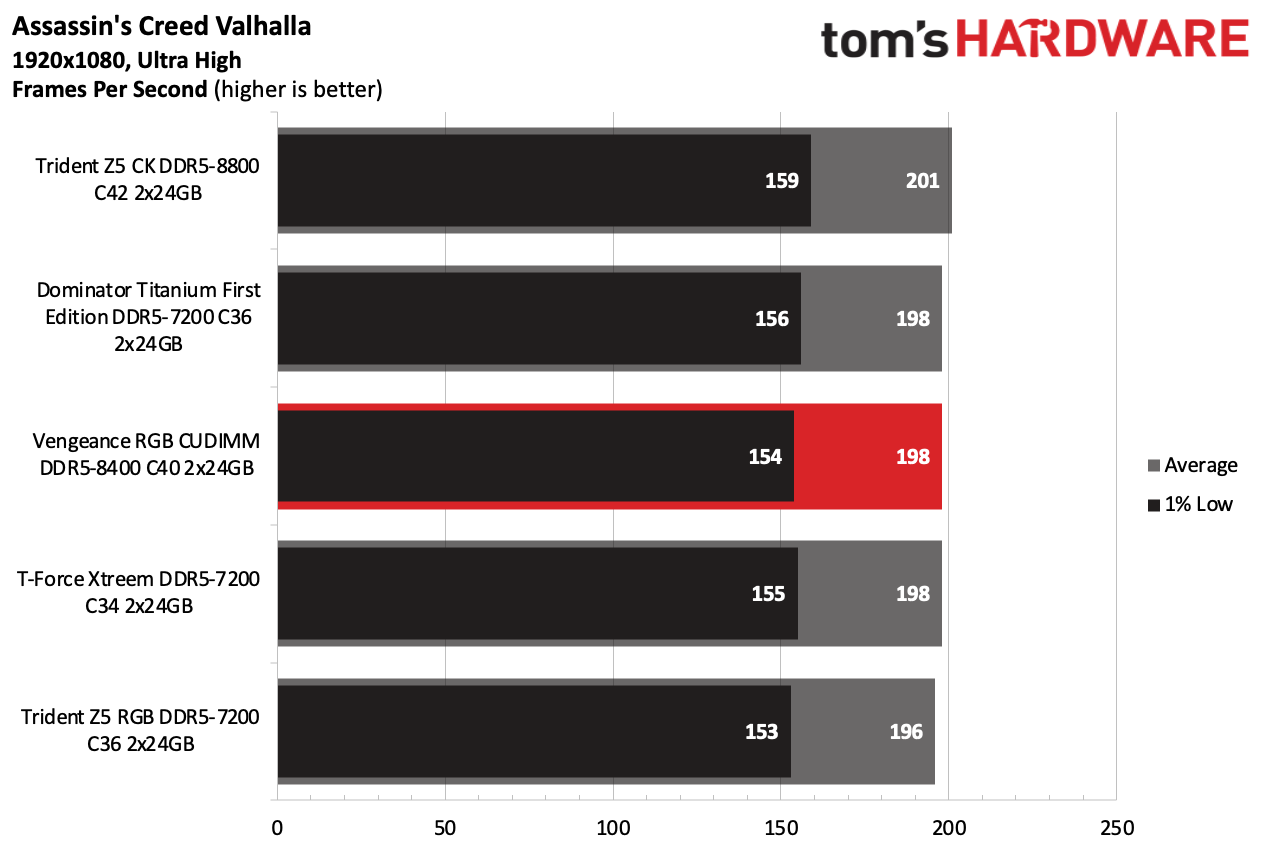
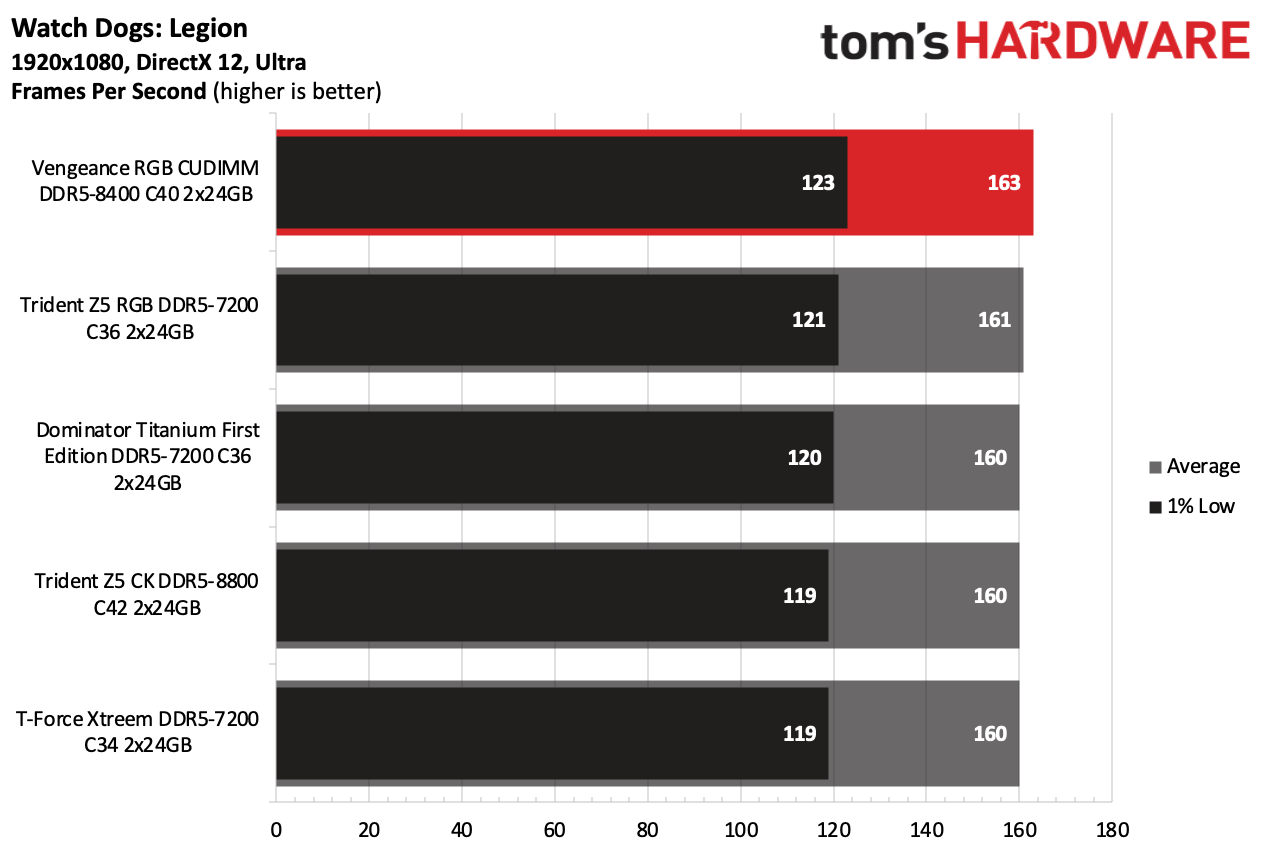
The Vengeance RGB CUDIMM DDR5-8400 memory kit demonstrated commendable performance in our benchmarks. It presently holds the third overall position among the 48GB (2x24GB) memory kits we've reviewed. In addition to its superior performance in the Microsoft Office benchmark, Corsair's memory kit excelled in the 7-Zip workloads, taking home the crown in both compression and decompression tests.
Regarding gaming, the Vengeance RGB CUDIMM DDR5-8400 memory kit ranks alongside the Trident Z5 CK DDR5-8800, establishing both as the fastest 48GB memory kits available for gaming purposes.
AMD Performance
Regrettably, DDR5-8800 exceeds the limitations of our Ryzen 9 9900X sample. The integrated memory controller (IMC) of the 12-core Zen 5 processor cannot accommodate memory of this speed. Consequently, our system would not post with DDR5-8800 memory. Unfortunately, AMD's existing platform doesn't fully leverage CUDIMMs' potential.
Although we had better luck with the Ryzen 7 9700X sample, our system remained unstable and frequently encountered BSOD errors. Due to the extent of the system instability, the Ryzen 7 9700X could not satisfactorily complete our benchmarking tests.
Overclocking and Latency Tuning
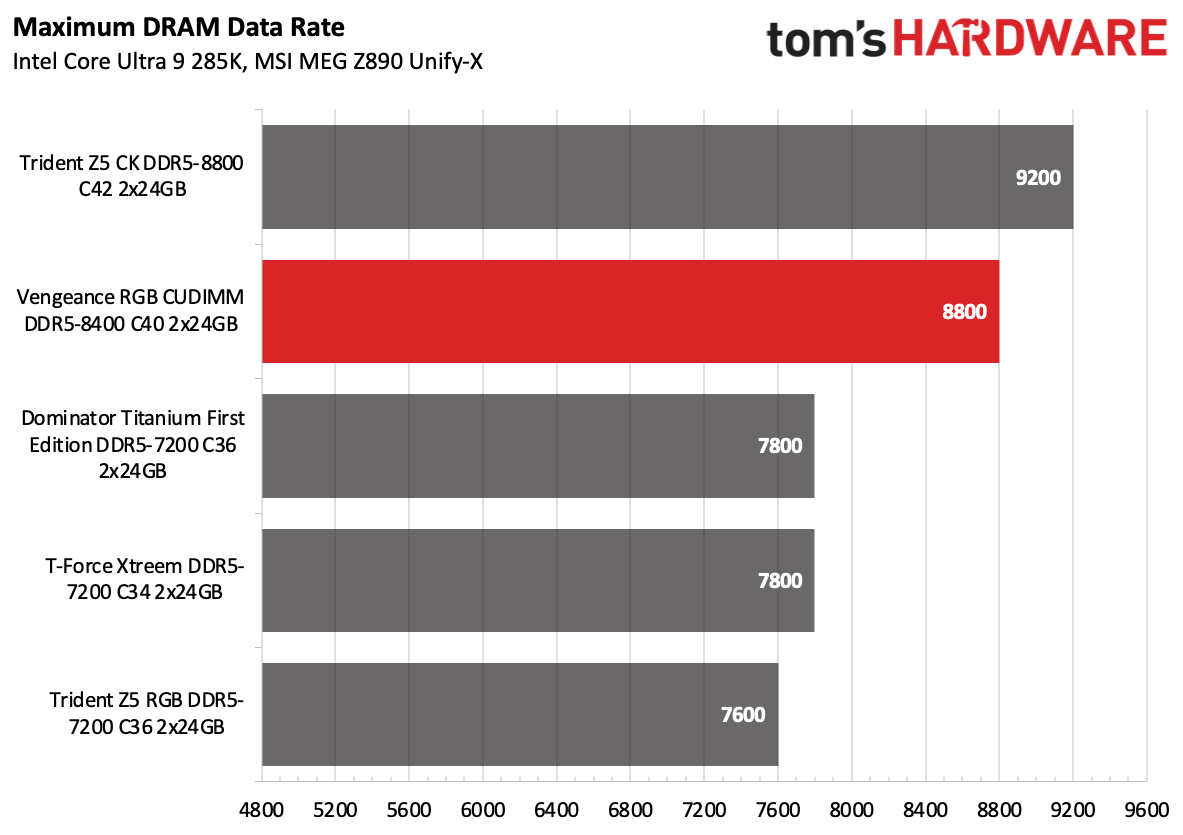
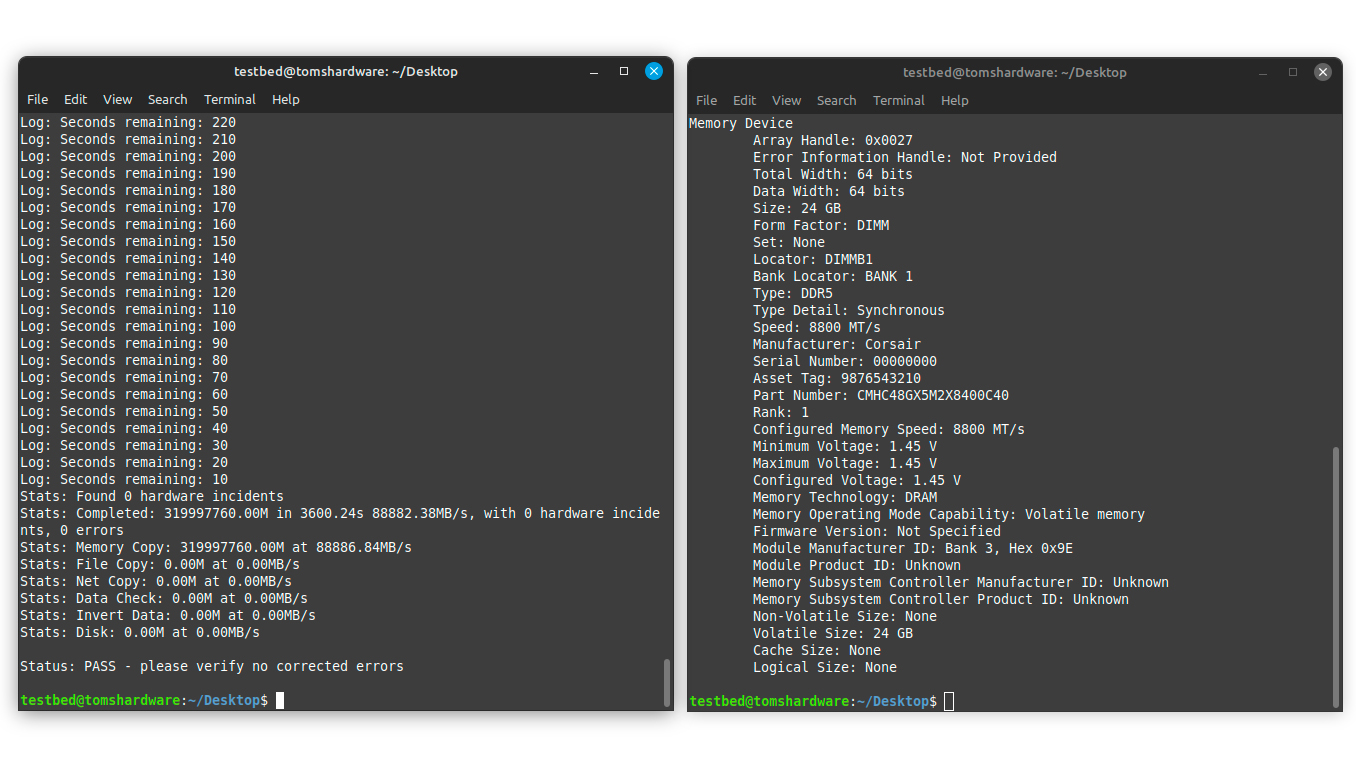
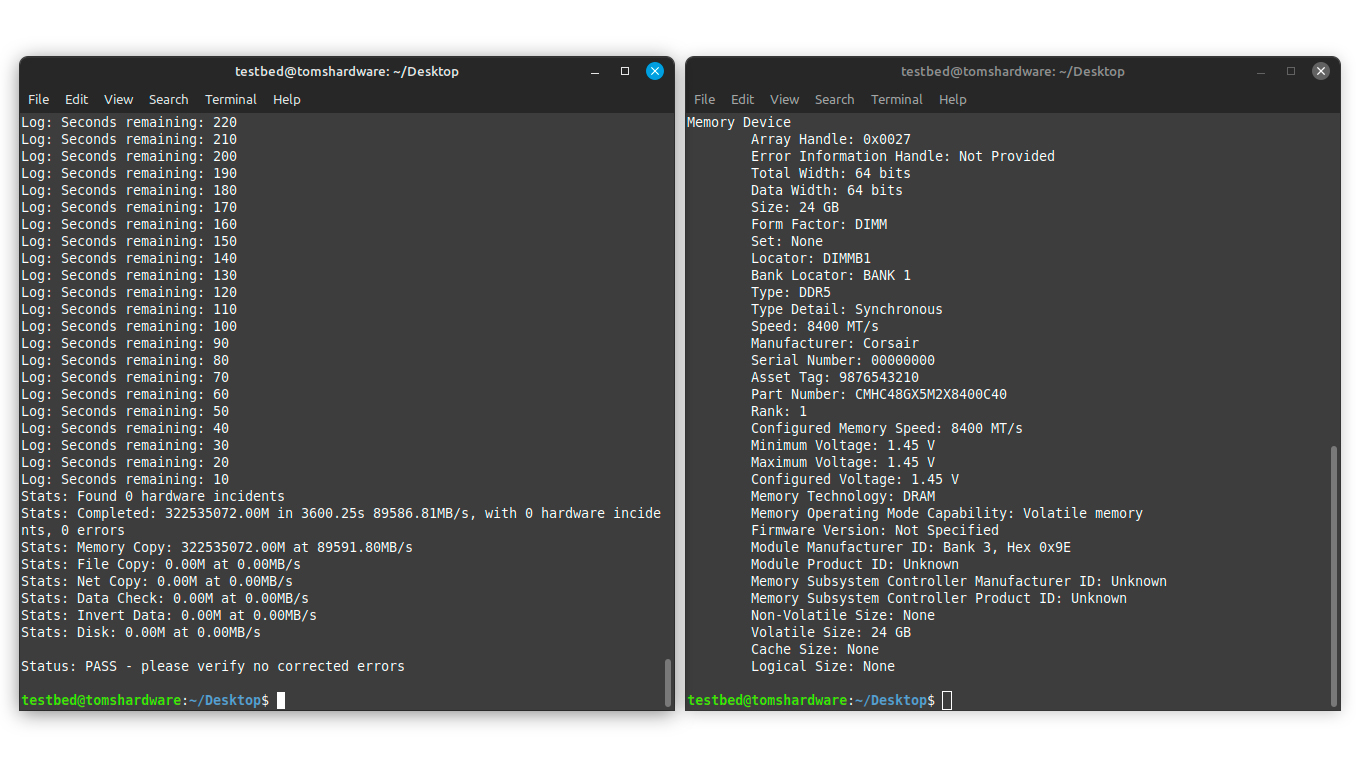
SK hynix M-die ICs are always a pleasure to overclock, and the Vengeance CUDIMMs are no exception. Increasing the DRAM voltage from 1.4V to 1.45V easily achieved DDR5-8800 while maintaining the exact 40-52-52-135 timings as DDR5-8400.
The M-die ICs might have additional overclocking headroom, which would require sacrificing memory timings. DDR5-8800 with a CAS Latency (CL) of 40 cycles is quite good, so we opted not to pursue higher overclocks.
Lowest Stable Timings
Memory Kit | DDR5-7200 (1.45V) | DDR5-7200 (1.5V) | DDR5-7600 (1.45V) | DDR5-7800 (1.45V) | DDR5-8800 (1.45V) | DDR5-9200 (1.50V) |
|---|---|---|---|---|---|---|
G.Skill Trident Z5 CK DDR5-8800 C42 | N/A | 40-52-52-134 (2T) | N/A | N/A | N/A | 42-55-55-140 (2T) |
Corsair Vengeance RGB CUDIMM DDR5-8400 C40 | 38-50-50-128 (2T) | N/A | N/A | N/A | 40-52-52-135 (2T) | N/A |
Corsair Dominator Titanium First Edition DDR5-7200 C36 | 34-42-42-82 (2T) | N/A | N/A | 36-46-46-116 (2T) | N/A | N/A |
TeamGroup T-Force Xtreem DDR5-7200 C34 | N/A | N/A | 36-46-46-86 (2T) | N/A | N/A | N/A |
G.Skill Trident Z5 RGB DDR5-7200 C36 | 34-42-42-84 (2T) | N/A | 36-46-46-115 (2T) | N/A | N/A | N/A |
While M-die ICs generally show excellent overclocking potential, they do not perform as effectively with tight timing configurations. With the same 1.45V DRAM voltage as before, we tried to achieve the lowest possible timings at DDR5-8400.
The outcome did not disappoint us. The memory ran fine with 38-50-50-128 timings, a few clock cycles lower than the advertised DDR5-8400 profile. The configuration was borderline stable, and with M-die ICs, you take anything you can get.
Bottom Line
The Vengeance RGB CUDIMM DDR5-8400 C40 doesn't have many weak points. The usual disclaimer applies to CUDIMMs and AMD's current platform. The primary limitation, not with the memory kit but instead processor support, is its design orientation towards Intel Arrow Lake processors; consequently, getting the memory to work stably on an AMD platform poses a significant challenge since CUDIMMs aren't fully supported. If you look past this impediment, you will see that the memory kit encompasses all the characteristics one would anticipate from a premium DDR5 memory kit.
The standard retail price for the memory kit is $349.99, which will deter many potential buyers. The Vengeance RGB CUDIMM DDR5-8400 C40 faces considerable challenges in competing, particularly considering that comparable memory kits in this segment commence at $249.99. Additionally, the Trident Z5 CK DDR5-8800 C42, which provides superior performance, is priced $30 lower than the Vengeance memory kit.

Zhiye Liu is a news editor, memory reviewer, and SSD tester at Tom’s Hardware. Although he loves everything that’s hardware, he has a soft spot for CPUs, GPUs, and RAM.
-
VizzieTheViz So can you actually notice any difference between the tested ram kits when doing anything with your pc? The differences in scores seems pretty negligible.Reply
I notice this in pretty much all ram reviews: everything scores about the same.
I’d say at this point ram is kind of a commodity: if you just have enough with a reasonable speed you won’t notice any difference buying a kit that costs 200 more (performance-wise anyway, it might have more rgb if you like that sort of thing).
Only real reason to buy the fastest ram you can get is if you’re running a cpu with a fast-ish built in gpu and no discrete gpu, like a really small pc built with laptop hardware. -
thestryker Reply
This has pretty much almost always been the case with DRAM. In the recent DDR4/5 generations there have basically been sweet spots of cost vs performance and anything above that sees increasing diminishing returns.VizzieTheViz said:I’d say at this point ram is kind of a commodity: if you just have enough with a reasonable speed you won’t notice any difference buying a kit that costs 200 more (performance-wise anyway, it might have more rgb if you like that sort of thing).
Of course whether or not there's any value in it depends on the person and workload. I bought DDR5-7200 for my system because it's pretty fast, but mostly because it was half the cost of the 8800+ at the time (things haven't gotten much better since).
If you play competitive games then the lowest latency kit with highest speed your system can run is the best choice which may justify the cost for someone looking for every last frame.